 16Likes 16Likes
 |
|

4 Dec 2011
|
|
Registered Users
Veteran HUBBer
|
|
Join Date: Mar 2010
Location: Bucharest, Romania
Posts: 117
|
|

Burkina Faso in the country with the most amazing skies

In Bobo we met the lovely Liana and Denis who are overloading through northern Africa with their dog

And back to Ouaga to apply for the visa de l'Entente that will allow us to enter Togo and Benin

On the side of the road you might find a poisoned arrow
|

4 Dec 2011
|
|
Registered Users
Veteran HUBBer
|
|
Join Date: Mar 2010
Location: Bucharest, Romania
Posts: 117
|
|
|
Tiebele and the Gourounsi Country

Soon after our visas were ready we were off to Po, through arguably the wettest region of Burkina. As this is the wet season and august is the wettest month of the year, the combo yielded some endless downpours that soaked us for days. Pitching a tent under the rain is a bit of a hassle, but it was nice to be cold for a change. As depressing as grey skies might normally be, they are still breathtaking beautiful in Burkina.


Breakfast in Po: omelet, tea, mutton soup.

The commune of Tiebele is reached via an offtrack piste. Over 100000 people live here in 67 villages. The area is famous for its mud architecture, that remains to be admired only within the small "royal" compound.
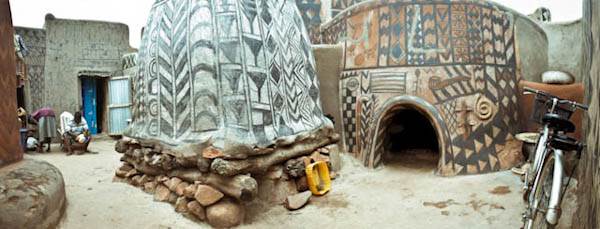
The compound is home to 300 people, the 54 families forming the extended "royal" family. The Kasena people who are part of the Gourounsi, have created some of the most beautiful examples of vernacular architecture. Their traditional houses are built in bank (mud mixed with cow poo) and have smooth shiny facaded decorated with unique frescoes. The married women use nere oil as a veneer to polish the outside walls, then apply different designs using all natural colors: laterite for red, basalt for black and kaolin for white. Unfortunately the traditional ways are still alive only within the compound, outside it s wall only a handful of homes bare the intricate frescoes that are modernized with black bitumen brought in from Ghana.

The entrance is the also the divination area, where the elders congregate and where animals are sacrificed for the benefit of the entire community. After this sacred area there is small field where the animists are buried in 15 people vertical graves. The closed graves are leveled and marked with a stone, the small É are still "in use" with the pot serving as symbolic door.


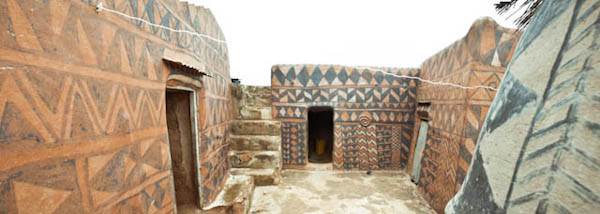

There are two types of houses: rectangular (for unmarried young men) and figure 8-shaped (with an entrance salon, a room for the woman and a winter kitchen). There are no windows, only indirect lighting. The entrance door is so low that you must bend to get in and it is followed by a 60cm wall that would cause any intruder to stumble and be easily killed. The darkness inside and the nere veneered walls also support the defensive nature of the Gourounsi homes, which have karite wood roofing and terraces for drying the spices and grains.





Baobab flower



The buildings with straw roofing are granaries.


Huge clay pots handmade by women in the neighboring village of Boudou are used for cooking or storing

A display of typical Gourounsi symbols. From right to left: the fishing net; tribal signs (traditionally used as identity cards, now used as beauty marks by some women); macrame for the calabash pots.


Calabas pots

Handmade mill for millet (white stone) and for peanut paste



This Kasena woman is 82
|

4 Dec 2011
|
|
Registered Users
Veteran HUBBer
|
|
Join Date: Mar 2010
Location: Bucharest, Romania
Posts: 117
|
|
From Tiebele we continued east on the 18km piste, then turned left and rode 20km more to Zabre, where the massive downpours and the river had made the road impassable. We took again a left turn and 25km later we were in Dondeou, still far from the sealed road, and too tired and too wet to continue riding through slippery mud and puddles.


We set camp under a karite tree that offered us a tasty snack in the morning. The rain kept on going through the night, stopping miraculously for a brief while, allowing us to pack everything and hit the road again. This area of Burkina is beautiful and hardly travelled, filling our hearts with nostalgia about a very improbable future return.
|

4 Dec 2011
|
|
Registered Users
Veteran HUBBer
|
|
Join Date: Mar 2010
Location: Bucharest, Romania
Posts: 117
|
|
|
North & Central Togo - Them Bloody Loud Roosters

You may be crossing a modest border, where a rusty sign barely reads "La Republique Tolgolaise", but this is not a country you can miss. The diminutive Togo is loud and proud and it was to become one of our trip's highlights. At the border the police are half men, half con artists, half stand-up comedians and there is that joyful somewhat slimy feel of a route people place. A transit visa can be issued at the border (and later extended in Lome). We've got the Visa de l'Entente valid for 2 months for Togo, Benin, Niger and Cote d'Ivoire, issued at the Surete office in Ouagadougou. To apply go from 7.30 to 11.30 am to the building on Av. Kadiogo with your passport, 2 photos and 25000 CFA; the visa is issued within 8-48 hours. The Laissez Passer for Togo is processed in the pink building on the right, just behind the police station, and it costs 6000 CFA (5000 the laissez and 1000 laissez registration or the  for the officer… we'll never know). The good news is that gas is cheaper in Togo, at 595 CFA/l.
The 650 km long Route Internationale in the Togolese Autobahn, connecting West Africa to the Atlantic coast and the duty-free shipping hub that is the Lome port. This very important artery is heavily transited by innumerable hyper-loaded trucks, wearing off the poorly sealed tarmac. The first 50 km have huge potholes that could swallow a car, putting to shame the untarred section of Route de l'Espoir. After Dapaong, a dusty little town where we stopped for the first togolese lunch of pate and sheep head, the road is very good, so we were able to ride safely to Kara.

Pate - a corn based sticky polenta (the staple food in West Africa) with sheep brains and meat in a very hot sauce and a local 
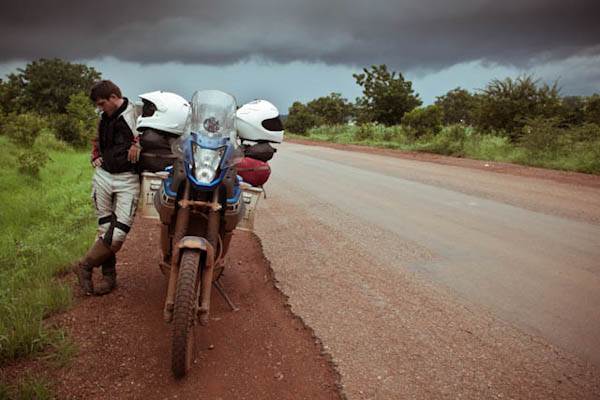
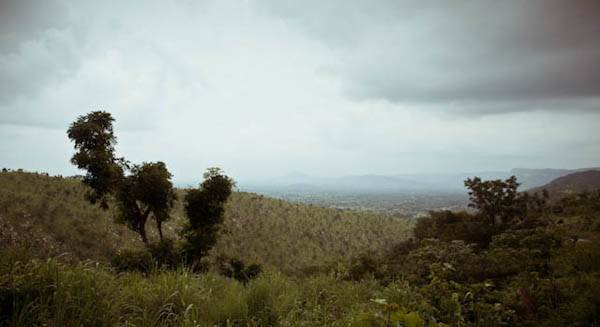
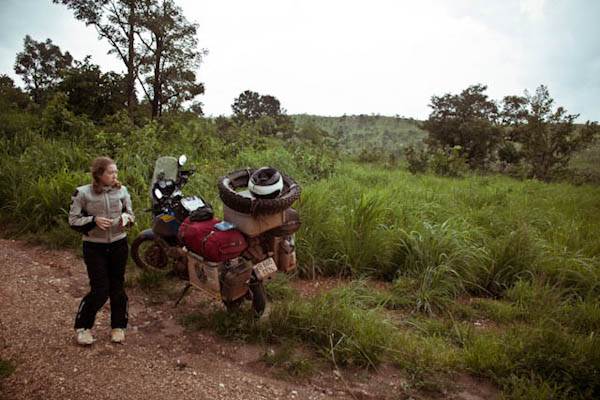
En route to Kara we crossed the scenic Mt. Kabye area, covered in lush banana, millet and rice plantations dotted with karite trees.
Arriving late in the evening in the town where the incumbent president poured significant cash into was a paranoia inducing experience. By nighttime the Togolese get their groove on: cars and scooters zoom by chaotically (many with no lights on), streets are buzzing with food vendors and smoking grills, fluorescent lit pubs are loudly broadcasting the local taste in music. To us, coming from the tranquil rice paddies of southern Burkina and after crossing muslim countries during the Ramadan, it felt like being swept into a very piney beach party. Togo is divided between two dominant tribes: the muslim Kabye control the north, while the christian Ewe inhabit the south. We decided to get a room to wash some stuff and dry our soaking wet tent and boots and on the way we grabbed a yummy street dinner: rice with beans, hot sauce, eggs and corn on a cob. The Togolese nights are long and extremely noisy, with people engaging in onomatopoeic conversations. Mornings though kick off with innumerable roosters giving a very loud wakeup call, so we barely got a few hours of good night sleep. In the early hours of the day Kara market is a lively beast. Breakfast joints sell rice and beans with sauce, meat, bread and hard-boiled eggs. Women carry boxes with doughnuts and bread on their heads like some kind of eccentric colorful hats. We bought a huge sweet pineapple and some uneventful grapefruit and later checked out the local dancing talents at a Maggi cubes sponsored contest next to the market.

Pate is sold wrapped in plastic or in banana leaves - 25 CFA

The price of a Lipton Tea includes a bread roll; you can add scrambled eggs

A local landmark
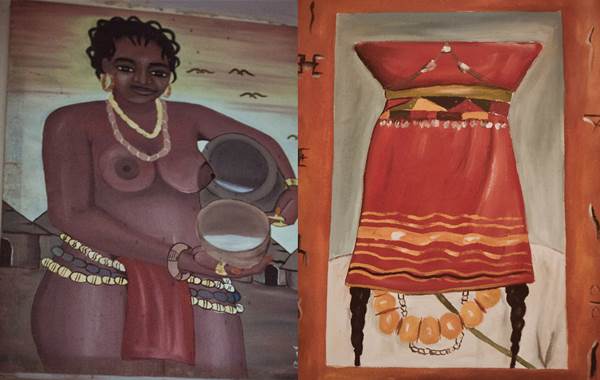
African beauty (left) vs. a Moroccan depiction of a woman
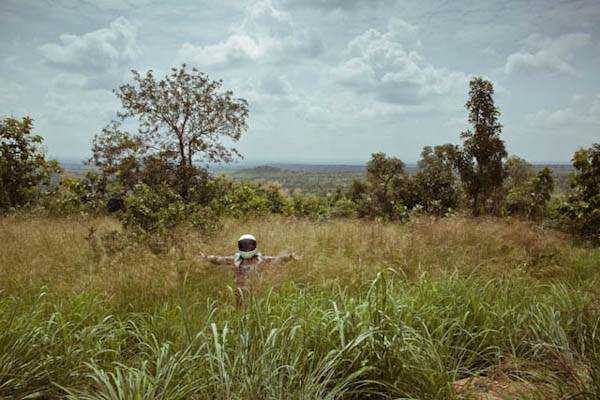


The grass is as tall as a man along the road that crosses six geographic zones, from the Sahel in the north, to central rolling hills and dry savannah, stretching further to the plains that border the ocean

We continued south to Bafilo, passing through the diminutive and postcard perfect Aledjo Fault and the many trucks and car wrecks that are sometimes left to rot in the middle of a turn. We rolled into Sokode - the second largest city of Togo - in time to stubble upon a group of girls selling freshly cut coconuts and to have lunch.

Lunch in Sokode: corn pate, okra, Guineea fowl with sauce and some mysterious bushmeat stew, gamey and delish. We cannot help but feel a little weird, as poaching is serious business in Togo

Atakpame was our target for the night, en route we passed the village of Yomaboua, in Sotouba district. This was the first slave trading base from where people were herded to the river for washing, then hot iron marking and shipping by train to Lome. Every year African countries observe the world slavery day, to find out more visit
We spent two nights in Atakpame at Auberge de l'Amitie, a chilled out place at an unbeatable price, where we took a shower and streched our bones. The auberge was a much welcomed rest, especially the second night, when we returned here after more than 200 km of potholed tracks, up on the coffee and cocoa planted hills beyond Badou. We arrived too late in the afternoon in Akloa to hike to the waterfall, but the ride was beautiful, if tiresome. The route passes with twists and hairpin bends through sleepy villages with hardly more than 10 mud houses with straw roofs, where the occasional local dj is blasting loudly some engaging african beats. As it's the rainy season, there are big water puddles and many muddy patches which are a bit of a hassle to cross. The beautiful panorama from uphill reveals rural fruit plantations and wild tropical forests, but also the heavily forested savanna below, where poaching and overpopulation are serious environmental concerns. That is correlated with the governmental lack of commitment for conservation; there is a swiss foundation working to repopulate with wildlife a small park in central Togo, but hunting is still allowed (we even saw a dead monkey carried by 2 men).
We are amazed at how different this country is from its neighbors: people have distinct, more rounded features; they are very easy going and many don't even notice us, too involved in their daily chores to care about becoming impromptu guides. The few who interacted with us were genuinely nice and never asked for money or stuff. Maybe in Lome things will change. As we are in the month of Ramadan (Careme), the predominantly muslim northern half starts grilling it's spicy brochettes only after dark, so breakfast and lunch can be find only at street stalls: pate, rice, chicken, bushmeat, sauces, boiled eggs, avocado, corn on a cob. Beware of the local favorite sandwich: bread with mayo. Bread can be salty or sweet, almost like a cake, eaten with a millet porridge (boui) for breakfast. Weirdly, the ubiquitous unappetizing fried doughnuts are preferred by africans to the amazing fruit they have lying around.

Breakfast in Atakpame: avocado salad, rice & Guineea fowl in tomato sauce
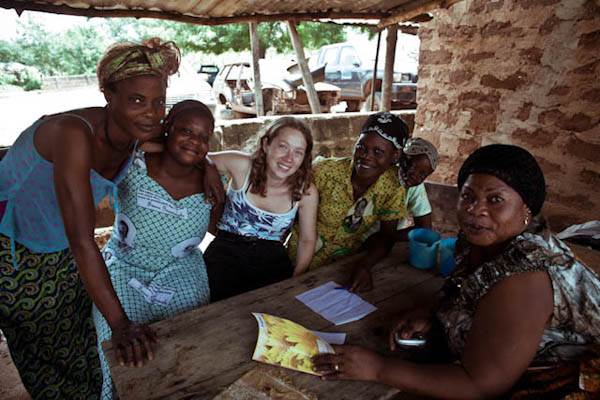
The breakfast joint where the girls have quickly become pals. As always, we are asked for our phone number and to help them come to Romania or Europe.
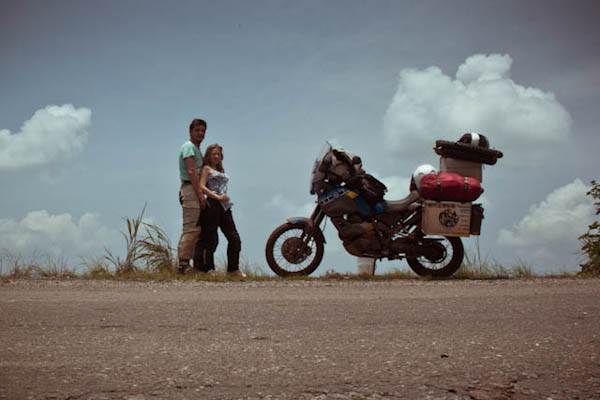
Up on the mountain on the way to Badou

We found one tasty treat, loved by kids: sweet peanut paste with a dash of chili (Klo-kluoi)
|

4 Dec 2011
|
|
Registered Users
Veteran HUBBer
|
|
Join Date: Mar 2010
Location: Bucharest, Romania
Posts: 117
|
|
|
The Lingering Smell of Dictatorship
Wake up at 6.20sh, yoga with Tony Horton or do laundry, fix breakfast, say hello in Ewe to a gazillion people on our alley (all too familiar with our life story), negotiate the mad traffic to Lome (sandy deviation and bribes for the barrier people included), go to meetings, lunch at Maman's or at fufu bar, crash in our tent, repeat. This was our routine for the long 3 weeks we spend in the capital city of Togo. Lome is now like home. We have become familiar with life in this sprawling African city, most of which is under construction: streets are being paved or redesigned, sky-scraping bank HQs built, parks delimited. The major infrastructure operations are controlled by the Chinese, but the underpaid workers are Togolese, with wages starting at 800 CFA/day (1,20 Euro).

Street workers are fancy
Similar wages for the military personnel, a very conspicuous presence all over town, especially when the largely hated president passes through, stopping all traffic at very irregular and unpredictable hours. The president is the son of the former defunct chief of state who was a feared dictator and who messed up big time. Even if some reform has been implemented, the past is still part of the present. The president is serving for his second mandate, but it is likely that at the last minute the constitution will be altered so he can hold on to power for as long as he wishes, despite voters' choice. We witnessed one presidential escort crossing through downtown and the strong reaction it generated among the infuriated residents of Lome, who had to stop and wait at gun point for the shiny limousines to pass. Also while we were in Lome one of the many siblings of the president went on trial for conspiracy to organize a military coup about a year back. That again stopped all Lome for two days and tied people to their radios, but one can't help but wonder about a positive outcome. As our long stay allowed us to be close with a few locals, whom we spent time cooking, sharing our life and chatting till night would fall, we learnt some worrying details about what it means to live in a modern African dictatorship, something that us, Romanians, have almost forgotten. For example, if you would buy a nice car in Lome you might be asked to pledge it as a gift to the president and if you would open a new business you might get yourself arrested and held for inquiries about the source of your money. And I could go on.

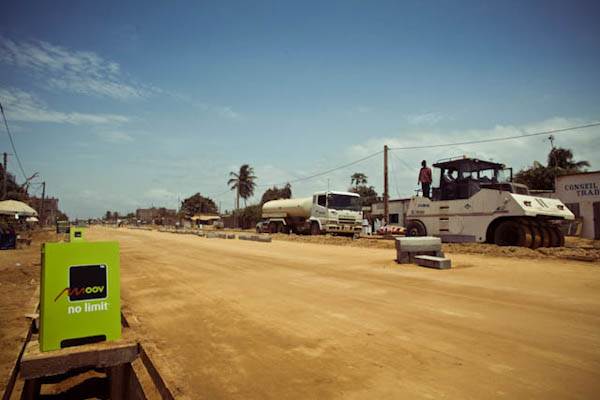
Lome infrastructure developed and financed by the Chinese
The suburbs are organized by districts or neighborhoods, controlled by a local chief who is elected during an elaborated ceremony from the "royal" family". People rely on their chief for all social matters, which makes them less aware of their power to elect and change governments they don't approve of and is allowing dictatorship to flourish. Preserving the tradition whilst living in a modern society is not easy.

Initially we were not planning to come to Togo at all, but here is Tony Togo, the only KTM dealer in the are where we could service the bike and repair our topcase, which had fallen off after kms of bumpy driving. .

Our Tenere next to its older avatar
We are staying at a well known overlander's joint, Chez Alice. As this blog is sharing our honest opinion, we are forced to badmouth the place. In a word, it stinks. Literally. The decaying huts smell and the communal toilets reeking of piss are unbearable; the monkeys, imprisoned in the name of love, are embarrassing to watch. Due to the ongoing street works, we were far from anything of interest and wasted a lot of time on dusty and sandy detours to Lome. First morning of our arrival one of the dogs bit me and teared my only trousers, Alice didn't care. But if you are like us, and decide to stay for the cheap camping (1000 CFA each), ask the lovely Yawo to let you pitch your tent in the second compound, which is quiet, clean and pleasant.

Now let's stop ranting about and focus on the food again. Prices are higher in Lome than elsewhere in Togo, but street food is spectacular. The Togolese are passionate foodies, with countless variations of sweet and savory treats widely available. We had superb lunches at this central street-restaurant, where a family serves on weekdays from 1 pm rice, beans, pasta and pate with various proteins in chili sauce. To find this gem, get in line with the business people on Av. 24 Janvier, opposite Boston Pub, near the French Institute. Also you will find here excellent homemade lemonade and bissap juice.

With Maman Victorine, the queen of Lome lunches, cooking some of the best rice we've had in years.

Ana with Beauty, the lovely daughter of the lunch lady and our new friend. She is beninoise/ togolese, spending holidays in Togo helping her mum

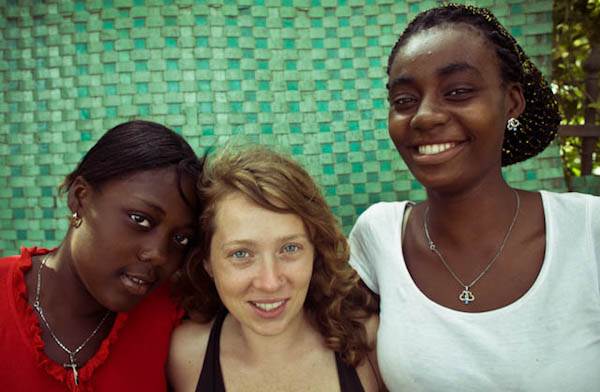


Another popular street food: pate rouge (millet flour, corn flour, tomato paste, tomato sauce, onion, peppers, Maggi cube) with chicken wings and yam wedges
Fufu bars serve a tasty West African staple, now in season: yam fufu with sauces (peanut and mackerel, tomatoes with onion or spinach and beef)

Boui, a millet porridge, is served with sweet bread for breakfast. We don't care so much for it (preferring to prepare our own guacamole with vegetable salad, or to eat chili beans with eggs in the morning)

African Cola - a popular corn and caramel soft drink

Togolese cheese is a delicacy made from cow's milk and wrapped in a leafy plant that gives it a reddish hue; is usual sold in the north and also at the Benin border

Few days into our stay we settled for this hearty breakfast: beans with chili oil and cornflour.

And the inescapable African food fetish: sugar cane
We were happy to see again the ocean after weeks of riding through desert or landlocked savannah. The beach is nice, but not unspoiled, whith houses and bars lining the ocean. The waves were too strong for swimming or for fishing and the seafloor is quite steep. When the sea got calmer we found great fish and seafood at local fishermen.
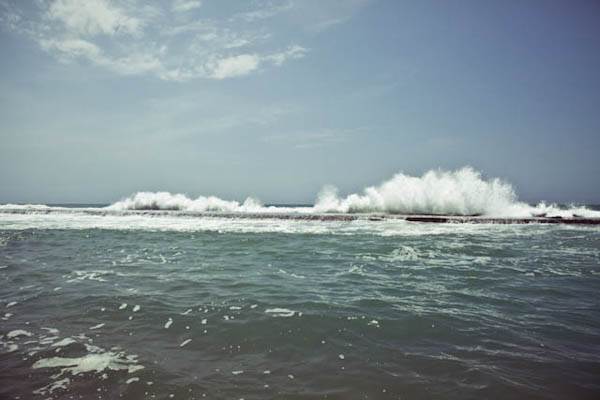


In Lome many locals grab a picnic or catch a game of foot on the beach that lines the Atlantic coast.
We would have stayed in Chez Alice only as long as we needed to wash our stuff, but in Lome we faced the troubles of getting the Nigeria visa. After being rejected once, we thought we should attempt to obtain a letter of invitation and try again. The Sallah holiday pushed our next attempt at the visa one week later, as the whole Nigeria stopped to celebrate the end of Ramadan. This extra time allowed us to meet the mini Romanian community in Togo and the honorary consul, Mr. Alin Roman, head of Togolese Dacia/Renault subsidiary, and who very graciously assisted us with the visa. As always, the expats from our country who chose to live in Africa are not ordinary people. We were invited for a delish fusion dinner at Virginia's and enjoyed yummy traditional Romanian dinners at Stefan and Nicoleta's. Romanian cheese is nothing like its French, British or Swiss counterparts (we had smoked cow cheese and sheep cheese in fir tree bark); it is rustic, but still handmade in mountainous areas from fresh unpasteurized milk; quite tasty, goes nicely with a dry red wine. Eating this simple cheese in Togo suddenly felt exotic and we wondered again why the Romanians don't cherish their heritage more, while being more fair about our flaws.

Together with Alin Roman and Mr. Dumitru at Dacia showroom


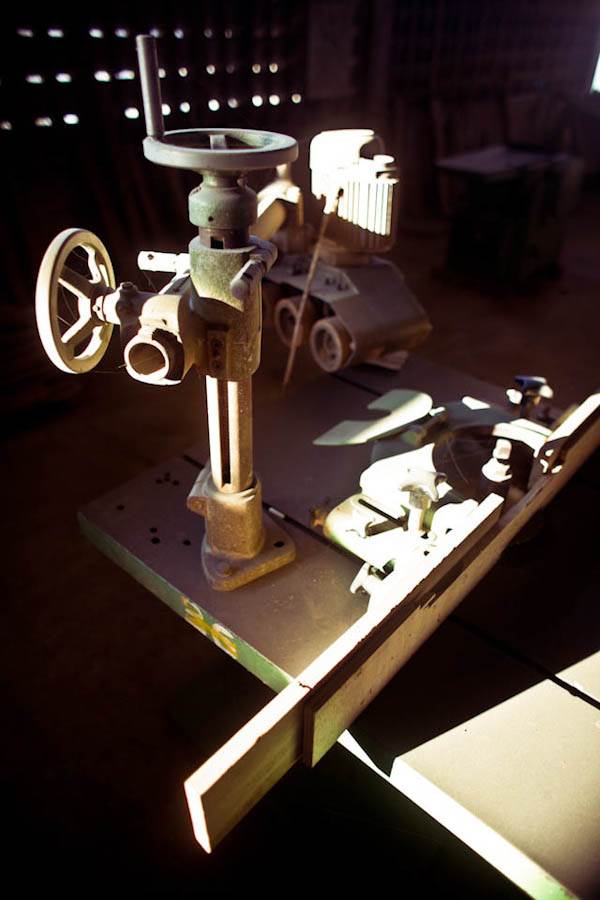

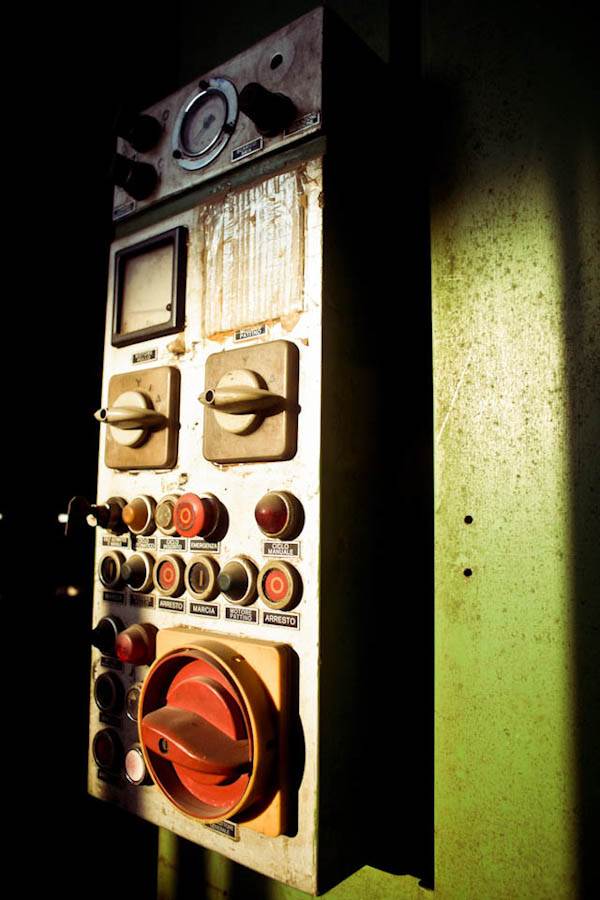
Images taken inside Togo Bois, a teak factory headed by Stefan

|

4 Dec 2011
|
|
Registered Users
Veteran HUBBer
|
|
Join Date: Mar 2010
Location: Bucharest, Romania
Posts: 117
|
|
Lome was the place to fix another small disaster that hindered our travels since Ouaga. Our GPS - the one that we had to buy back from the thief in Morocco - broke there and proved impossible to repair. This time we decided we cannot be cheap again and went for the expensive but hopefully more sturdy Garmin Zumo, that we bought online, had it shipped to Paris, had a friend carry it to the airport where a contact of our consul brought it in Lome by airplane. Let's hope that we won't have to dig again this deep in our pockets or we may have to go home sooner than planned.

I am ecstatic for the new GPS


We were lucky to find many like-minded people in Togo. They (Gaspard, Devine, Blondine, baby Lea nicknamed Chocolate, Nesto, Epiphany) were our daily buddies, happy to share a laugh, taste our cuisine, watch us exercise and listen to our travel stories spiced with pics and videos.

After 3 weeks we were settled into our own rhythm, eating and fruit shopping at the same ladies, moving about like locals, when we finally got the Nigeria visa. We happily packed our stuff and set off to Benin, not before ditching the very used tires that took us over 14000 km and after mounting the knobbies (fingers crossed that they'll last till Namibia!).




Ready to make a move and gulping our last beans'n cornflour breakfast.

Exit Togo via a serene road that lines the turquoise ocean after the fetish center of Aneho


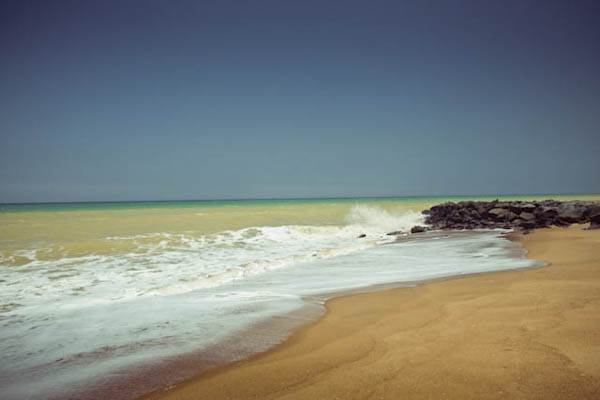
|

4 Dec 2011
|
|
Registered Users
Veteran HUBBer
|
|
Join Date: Mar 2010
Location: Bucharest, Romania
Posts: 117
|
|
|
BENIN - Fetish or Coconut Country
This wasn't at all what we expected. We chose to stop in Togo to service the bike and got stuck there for over 3 weeks for the Nigerian visa, so had less than 3 days left to see what we could from Benin. We created quite a sensation when we showed up at the border, where Togolese and Beninese crowds cross over on foot and where street-side stalls with brochettes and fried yam are catered for by Nigerian refugees arrived here at the end of the 90s. We already had a visa so we asked for a cheaper Laissez Passer that would allow us to transit the country. As there was no such thing, we took the custom officer's advice and set off without, only to regret the decision 3 days later, when we had to negotiate the price down from 20000 CFA to the original 5000 CFA. Gas is 540 CFA/l and roads are in poorer condition. We stopped over for a fufu after the dusty resort of Grand Popo, and rolled cheerfully towards Ouidah.
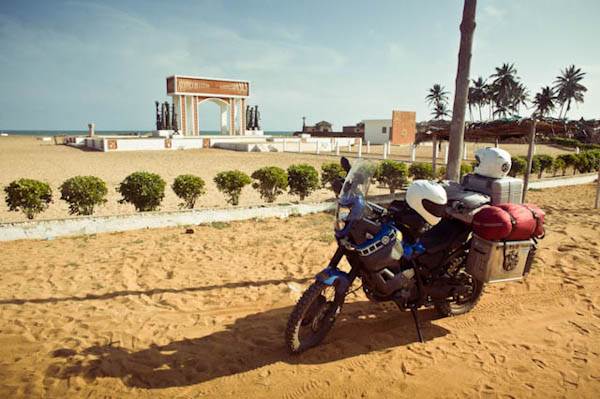
In the XVII-th century Benin was still split into several principalities, but eventually one chief prevailed and started in Dahomey (present day Abomey) a bloody dynasty of ruthless kings. Their leisure consisted in frequent invasions of the neighboring Yorubas in Nigeria and building bank palaces rumored to owe their red color to the blood of defeated enemies. Also they eagerly cashed in the gold from the very lucrative slave trade based in Ouidah and Porto Novo and run by the Portuguese, the French, the British and the Dutch. Between 1800 and 1900 over 10000 slaves were shipped by boat from the so dubbed Slave Coast to Brazil and the Caribbean, particularly Haiti. The slaves brought along a robust gastronomy, lively folklore and the voodoo tradition, which was formally recognized as religion only as recent as 1996.
It's hard not to get emotional along the 4km that were the last walked by the slaves on their way to meet their destiny. Ouidah is today a sleepy resort with largely paved roads, but this lonely route lined with palm trees, fetishes and monuments was symbolically left untouched. The sandy piste passes by the monument of the Tree of Forgetfulness, the tree that once stood here was circled by the slaves to induce eternal oblivion upon their previous life in Africa and erase their home memories. At the end of the line we found ourselves in front of the Point of No Return, a monument that recalls the 1970's marxist regime rather than the emotional life of the African slaves. We gaze for minutes into the abyss of the horizon, beyond the forever blue that was once that last image on the retina of many people, before descending into the darkness of their implacable fate.
Not far from the Point of No Return we enjoy a lovely chat with a bunch of youngsters who sell some meaty and fragrant coconuts. We choose to roll towards Cotonou on the beautiful Route des Peches. 42 of sandy piste, and the knubbies make the difference. Barely ten fishing villages are quietly lining one of the most romantic routes we drove on in Africa. Traditional vegetal huts, old boats carved from a whole tree trunk, we ride alone while digesting the heavy emotions from earlier. In the magically warm and long light of the sunset, the clouds of sand our Tenere leaves behind are shimmering like gold.


We find drinking water at some generous shy fishermen and later we look for a camping spot in the beach. We end up near the compound of a local chief, a very well spoken and dressed man, who welcomes us happily. We stay up late chatting life and food and in the background the capital lights up the night. In the morning we brew black Sri Lankan tea with milk for everybody, and they feed us the best coconuts ever. On the beach the fishermen have already formed a line and are sweating over the full nets.

Cotonou makes quite an impression on us: solid infrastructure, modern office buildings, a maze of a market, good street food but an insane traffic and kamikaze zemi-johns (motorcycle taxis) zooming from very direction. Benin was dubbed The West African Latin Quarter because of its people: loud, energetic and very chatty, always glad to start an intellectual or political debate.


We were meant to be heading for Abomey, in the heart of the Fon country. The 140 km of bad potholed tarmac proved a boring ride, along which we met just dilapidated trucks with hysterical drivers. This was the main road, so we decided to drop the idea of going back to Cotonou the next day on a secondary road, but we cringed at the thought of having to ride on this road not once, but twice. The historical capital of the bloody kingdom that shattered the peace over a huge chunk of Africa didn't impress us as much. UNESCO has pomped some money to establish the Dahomey Trail, along which the former palaces are scattered. But the buildings are either abandoned to ruin or so neatly restored that they appear brand new, and that doesn't help with the overall charm. The locals can't be bothered to cater for the old sites but are eager to collect any money they can squeeze from the tourists. We forfeit the pricey museum ticket and head to the market, to browse the voodoo merchandise on sale.

Voodoo comes from the Fon and Ewe word vodun, which means hidden or mistery. The present set of beliefs are an amalgam of traditional and catholic ideas that formed in the Caribbean. Voodoo is a daily aspect of life in both Togo and Benin. The fetish market is like a voodoo pharmacy, where the wood dolls and dead animals' parts (gri-gris) can be purchased at the indication of a juju man. The ceremonies usually revolve around the consultation of spirits of dead ancestors, who are offered the gift of certain aliments or domesticated animals. Unfortunatelly the voodoo religion has been harmed by the policy of the marxist government that abandoned it to the exploit of Hollywood. We let you enjoy the pics of dead gri-gris and of an unfortunate but very much alive chameleon that un unscrupulous fellow would have liked to sell to us for less than 4 Euros.



In less than 24 hrs we were to roll for the first time into the dreaded Nigeria we'd heard so much about, and nothing could have prepared us for what was to come.
|

4 Dec 2011
|
|
Registered Users
Veteran HUBBer
|
|
Join Date: Mar 2010
Location: Bucharest, Romania
Posts: 117
|
|
|
Lagos - Inferno and Paradise
First, we were reassured that we would get a visa, "no problem" said the nice visa lady at the Nigerian Embassy in Togo. "We cannot issue the visa for you" she said when we showed up to pick our passports two days later. "The UN headquarters in Abuja was bombed and 20 people were killed in the attack" emailed Rotila. And Louis who was the only one who could have helped us with an invitation from a Nigerian company for the embassy was in bed with malaria. Everything that could go wrong went. And yet, on the 14th of September, on our 93rd day of overloading through Africa, we arrived at the border with a stamp in our passports that had bought us the right to enter the dreaded Nigeria. This is a different country in a new and raw way we haven't encountered since crossing the No Man's Land between Morocco and Mauritania.
After lengthy bargains with the Beninese custom officers and socializing with border police who fetched a trustworthy moneychanger for us, the rusty barrier was lifted and we were finally in. We knew immediately that this was the second A heat haze was frying the horizon and our nerves. I parked and went to sort out the papers. There were many tall slender AK 47 armed Nigerian officials asking for many un-officials fees. I showed them a pile of papers while explaining why we don't have a Carnet and hoped for the best.
"Your situation is very difficult", the tall slender AK 47 armed officer who picked me from the parking said. "You have to post a bond for your bike, that you may collect on your way out". After an hour and a half of intense negotiations we were friends. A friendship that cost a hefty 30 Euros (laissez passer plus stamps) and a headache. In the meantime Ana was busy chatting the other people off, while under the terrible suspicion that they were in no position to allay.
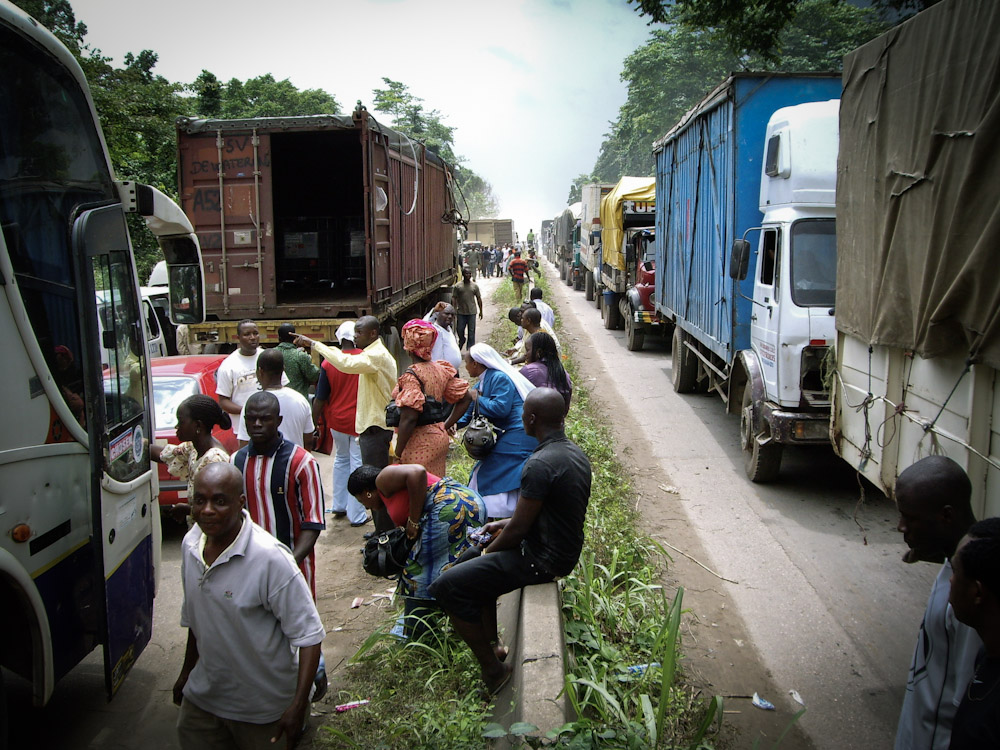
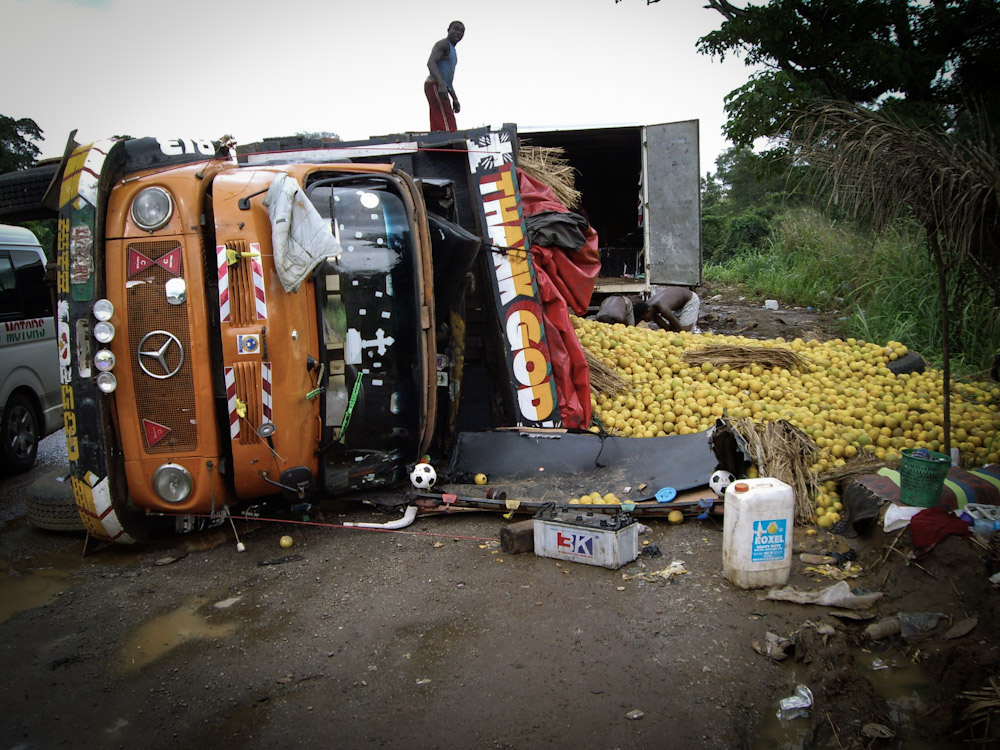
Road to Lagos - photo credits Nigerian media
The next 80sh kilometers were a shock to the senses: after the pauper but healthy street life we got used to in West Africa, suddenly we were navigating a chaos of brand new Q7s and MLs with spinners and custom rims, drivers in white T-shirts and oversized sunglasses with rhinestones. It was like stepping through the magic mirror into an alternate universe, but soon the luxury cars with 3.5 l tanks merged along dilapidated cars and trucks into a suffocating flow of petrol-heads on their way to Lagos. Every other 500m or so people in all sort of uniforms or - more alarming - civilians with guns would throw a wooden plank with hooks in front of the cars, forcing them to pull over. Sometimes we had to stop and chat until they forgot about asking for money. We shook many hands and smiled many smiles and told our story maybe 20 times but we arrived at Mile 2 without paying any Naira. The price for petrol is shockingly low: 65 Naira/l, less than 40 cents. Rumor has it that it is artificially controlled by the government to prevent civil unrest, because there are no refineries in Nigeria and the crude oil is exported to other countries, then later imported back as end product.
Nigeria is the most populous country in Africa and possibly the most diverse nation in the world, home to a vast array of people speaking an astonishing 840 languages. Yoruba, Hausa and Igbo are the 3 main languages, with english and pidgin widely spoken and understood. Immense natural resources, many untapped, coexist alongside sheer poverty. It is a country of extremes, where the rich are not in any Forbes statistics and where white people are constantly reminded by everyday life that they are no longer in power, but guests at a table where the best bets are up for grabs.
Hardly explored by tourists at ground level, clouded by terrorist Boko Haram and marred by a dihcotomic fight for the black gold of the Niger Delta, Nigeria was before us: a mystery and a challenge. Within the next month we were to meet the fringe Nigeria, surely unable to comprehend its vastness, not to get nowhere near the heart of it.

Life for ordinary Nigerians is tough, so they have to be strong enough to survive it. Here if you don't wake up and go out there and work hard, you die. If you stop in the middle of the highway, you die. If you are afraid to ask what you need, you die. It's that simple. Especially in Lagos. To come all the way to Nigeria and miss the fastest growing city on the African continent would be crazy. By 2020, Lagos is estimated to become the third largest city in the world, with 24 million people, and these are the official numbers. The many that get by in the slums of the mega-city remain unaccounted for.


Lagos - Victoria Island

The sand people: they can't swim, but they dive in the murky waters of the lagoon to collect sand in buckets, then they sell it for a few Nairas at construction sites. Most can't survive this job more than a few years.
Louis took Ana on an introductory speed boat ride through the port and I plunged into an introductory ride through the rush hour traffic of a megacity of 14 million. It was exhilarating and insane. Kamikaze motorcyclists were shuttling clients through every inch available. They are the okadas and their life is expandable. 4x4s, limos, minibuses, trucks and cars hurtle through the okadas at computer game speed. Red light, roundabout, lanes, sidewalk, traffic police are utterly useless bits. The point is to move forward by all means as fast as possible. 90 minutes later I knew hell had set up serious business in the streets of Lagos. And yet, I was digging it.
During the following 5 days we tried to look into the eye of this monster city. We fell under the spell of this unique, vibrant, mad, excruciating place of a million faces, born out of explosive population growth, a place that feeds on money and power.
In their book "Last Chance to See", Douglas Adams and Mark Carwardine wite: "in different parts of the world strikingly similar but completely unrelated forms of life would emerge in response to similar conditions and habitats." They talk about behavior patterns and about the gift shop "habitats of Spain or Greece" where "the local people cheerfully offer themselves up for insult and abuse in return for money which they spend on further despoiling their habitat to attract more money-bearing predators." Cities are immense organisms where, likewise, local inhabitants develop special skills to better adapt to the concrete and steel habitat. Dubbed the New York of Africa, Lagos has surely its Nigerian versions of the many life forms that populate every speck of one of the world's most intricate cities.
In this complex and paradoxical context, we visited Marine's workplace, the Louis Pasteur French school, where we we become subject of study for a bunch of reasonably rich and quite smart kids. We had fun asking questions like: "How did you cros the sea?", "How can you have Naira when in Europe you have the Euro", or "How do you repair the moto", "What do you eat", "How do you wash" or "Why didn't you take the plane?". We had a brilliant time, followed by another mad downtown crossing with Ana trailing our bike with an okada.



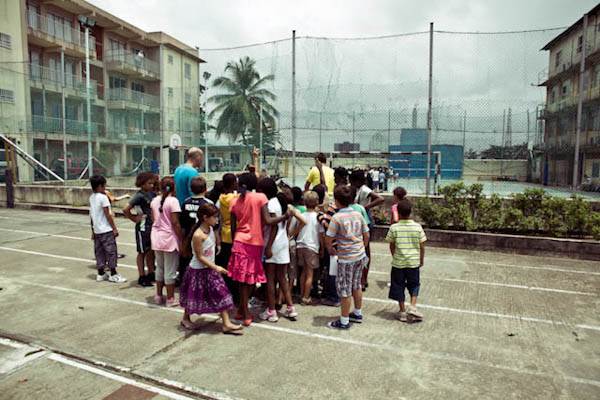

These kids were screaming of joy when they heard the price tag for my bike. One said he's got the money to buy it and that he's going home to demand his dad to get him a bike asap.
If Lagos can be hell by day, by night we entered the realm of sublime at The Africa Shrine, the Mecca of an unique music style that originated in Africa in the 1970s. Afrobeat is a polyrythmic fusion of Yoruba music, jazz, highlife, funk and chanted vocals, created by the genius Nigerian multi-instrumentalist and bandleader Fela Kuti. A spiritual leader, a hero to millions and a musical pioneer, Fela used Afrobeat in his own political guerrilla that revolutionized the political scene of Nigeria. His music was confrontational and spoke about an imperative and profound social change that was needed in the post-colonial Africa of the 1960s, where people were struggling with military coups and social discrimination. With psychedelic neon lights, an actual shrine bearing personal belongings and intimate photos of Fela, the place is a sound capsule which evokes the original legendary nightclub where the larger than life artist performed with the same incredible energy with which he enjoyed drugs and women. We saw the live performance of Femi Kuti, a "cleaner-cut version of his father", but a true artist, a soft spoken man who exploded into powerful harmonies and rhythms, combining and improvising with different elements. The show was completed by the jaw-dropping dancing of Femi leading a group of 5 women dressed in traditionally inspired attire. Beside hosting the weekly concerts of Femi and Seun, The Srine also provides a venue for new Nigerian talent and a space for intellectual debate.

The Shrine. Photo credits: The Shrine: The Unofficial Website for Fela Kuti and Afrobeat Music
The Shrine: The Unofficial Website for Fela Kuti and Afrobeat Music
Street food in Lagos is not easy to come by, so we wondered if we'll get a chance to sample more local cuisine, other than sue, a delicious Nigerian version of grilled beef, thinly cut and served with red onion and lots of ground pepper. But we also promised to visit Karen, a one of a kind woman and friend we met in Togo a few weeks back. Happy to see her and the family again, we were thrilled to enjoy the best Nigerian food we were to have during our whole stay in the country.

Egusi - a thick soup made from grounded melon seeds and bitter leaves, with goat meat and 2 starches: eba (the yellow paste made from cassava) and seem (semolina paste)

It was a biker's day. Max had to try on my Tenere and was fearless at 2. I tried his dad's K1.

Ana and Karen

Me, Karen and the kids

Ana sharing a smooch with her extended Nigerian family
|

4 Dec 2011
|
|
Registered Users
Veteran HUBBer
|
|
Join Date: Mar 2010
Location: Bucharest, Romania
Posts: 117
|
|
|
Makoko - The 103-year-old stilt-slum of Lagos

Our friends, Louis and Marine showed us some black and white photos of an unusual settlement nestled in the Yaba Local Government Area of Lagos State, and we knew we had to somehow get there.
Makoko is one of many shoreline slums threatened by climate change in Nigeria. Rising water levels, strong tidal currents and polluting human activities (wood burning, excreting in the lagoon, throwing harmful substances in the environment) are some of the problems Makoko has to deal with. This slum on stilts was initially a temporary fishermen settlement, mostly Egun people from Badagry and Benin. The population has continued to grow for more than 100 years into a community now largely abandoned by government. The small village has become permanent home to the poorest of the poor, pushed off the land because of the premium real estate prices in and around Lagos.


The village is built high above the 1,5m deep water, with houses supported by hardwood stilts driven into the water bed.

Every 30 years or so the houses require some maintenance works. It's a harsh environment where one must work hard to survive, but for the villagers, Makoko is home and they strongly oppose the federal project to relocate them. They are not interested to move in a more beautiful or healthier place, despite the evident degradation and pollution. Yaba Local Government provided plastic tanks for drinking water. There are no basic social amenities like health care, electricity and water supply or pharmacy.

The only primary school in Makoko is attended by aprox. 50 students who have to pay 50 Naira/day.
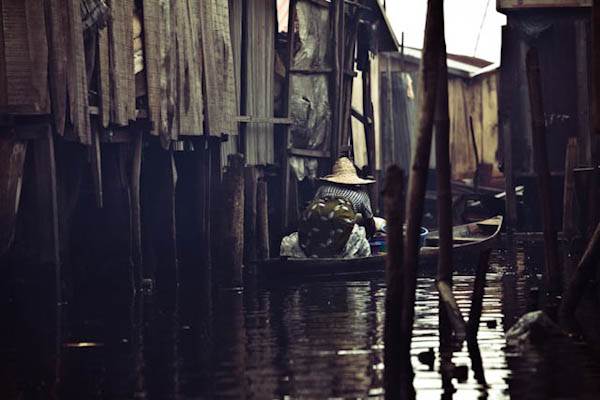





The adults - and many times little children - go about their daily business in their boats. Every family owns one. Fishing, shopping, selling food or goods is done from a boat. There are even floating restaurants, a mill and manna repair shops based in boats.


The murky water is almost black with litter and has the quality of oil. There is a calming poetry in Makoko though, gliding on the "streets" - narrow canals that open into the lagoon.






ThereÕs limited government presence in the stilt village of Makoko, the local gangs (called Òarea boysÓ) control the streets and the community issues are addressed by the Baale (the village chief).
Despite extreme poverty, there is joy in Makoko. This is no or Venice of NIgeria, but kids welcome yovos (white people) with smiles and adults are eager to chat.
|

4 Dec 2011
|
|
Registered Users
Veteran HUBBer
|
|
Join Date: Mar 2010
Location: Bucharest, Romania
Posts: 117
|
|
|
Abuja - An Unlikely City

And then there was the day to leave Lagos. We had fallen for this manic but vibrant, but we had to go. Our itinerary: cross western Nigeria to Abuja to do some visa shopping. We left on a downpour and crossed Ilorin and Ibadan, the city that was recently severely affected by floods and where about 200 people died because of collapsing buildings. By evening we were stopping in Offa, thanks to Karen who had arranged our overnight stay (cheers Karen!).


The 70s decor where we stayed for one night.

Waiting for the tropical rain to stop so we can take off to Abuja.
We were saddened by the poverty that is so evident in rural western Nigeria. People are struggling to come to terms with a fast developing economy. Focus has shifted from agriculture and manufacture to the oil industry, and not to everyone's profit. Food is scarce and lots of stuff is now imported and quite expensive. The road to Abuja through the Niger state was exhausting. Bad tar with potholes from side to side and a massive traffic: trucks, lorries, buses, minibuses moving about at mind boggling speed. 550 km, 10 hours of riding, 3 brief stops for omelet with tea and a visit into the bush.

Cossing the Niger river once again
By sunset we arrived in Abuja less than 3 weeks after a bomb exploded at the UN HQ. The terrorist group Boko Haram had already claimed responsibility for the attack in which reportedly 20 people were killed. Compared to Lagos, Abuja feels quiet and peaceful, but there is a lot of security in the streets, also because all diplomatic missions, NGOs and big oil companies are based in the very young capital of Nigeria. The city was founded in the early 80s. It has an impressive infrastructure due to Julius Berger Nigeria PLC - the same company that built the longest bridge in Africa, the 11.8km long Third Mainland Bridge, which connects Lagos Island to the mainland.


The church and the mosque are towering symbols of the Muslim and Christian nation.

In Abuja we met the Romanian community and the Embassy staff. Mr. Mircea Leucea kindly wrote letters to the various embassies we had to visit to support our visa applications. A week later we had Cameroon, Congo, Democratic Republic of Congo and Namibia stamps in our passports. During our visa runs we met Julien and Frank, two bikers overloading round the world on a brand new Super Tenere and on a BMW

We stayed for 2 weeks at Mircea Rusu's, a fabulous host who can cook a tasty salad soup. We cannot thank enough for the pampering and tips for things to see and taste in Abuja.

Ragu of beet with rice at Mircea's

There are many continental, chinese and french restaurants in the biggest cities in Nigeria, as Nigerians enjoy to travel. Prawns and Sole fish are exported from here to Europe, also prime quality red snapper, crocker, red mullets, as well as lobsters, crabs, gambas are available. The best grilled fish in the whole of West Africa is in Mammy Market of Moghadishu Barracks, Abuja. In the middle of the circular market choose your crocker from the many mamas, then savor it slowly cooked to perfection, with pepper, onion and tomatoe dip, lime and potato wedges. Absolutely to die for. Unfortunately at least 10 people died here in January 2011, when a Boko Haram bomb exploded.

The Nigerian cuisine includes a lot of red pepper, fiery hot. Some of the specialities are the pepper soup (usually with fish); eba, fufu (pounded yam), gari (cassava) with vegetable, fish or goat meat stews. The food is cooked in palm oil with indigenous spices and herbs. Our favorite was suya, the Nigerian version of brochettes: beef, liver, gizzards with lots of pepper, always a night deal.

Grilled pork with cabbage and red onion


Fufu with beef in tomato pepper sauce and egusi


Dried peppery Idemol caterpillar - a protein rich snack usually enjoyed with  . Has a mild fish flavor.

Abuja. Carrot and sesame salad, chickpea salad with feta and fresh basil, aubergine salad (a summer staple in Romania!), zucchini soufflŽ, chicken and flap jack with passion fruits for pudding.

The Gurara falls, in full force at the end of the rainy season

On the 1st of October, the national day of Nigeria, we stayed inside and watched on TV the festivities. Because Boko Haram threatened to repeat the terrorist attacks from last year, the ceremony took place inside the presidential villa and the whole city was deserted
|

4 Dec 2011
|
|
Registered Users
Veteran HUBBer
|
|
Join Date: Mar 2010
Location: Bucharest, Romania
Posts: 117
|
|
|
An Enchanted Night In The Rainforest Changed Everything
On the 9th of October there were presidential elections scheduled in Cameroon. The dictator Paul Biya, in power for over 20 yrs, was the expected frontrunner for yet another 7 years term. On the 30th of September an opponent of the current regime fired a gun in Douala, and the police found an unexploded grenade in Limbe, at the Elecam hq. On the 13th of Octiber our Nigeria visa would expire, so on the 4th we were heading from Abuja to the Ikom border, with the intention to cross into Cameroon and avoid the capital during elections or to bushcamp next to the border.
There 3 ways into Cameroon: the good tar up in the north, through Maiduguri and the highly unstable Boko Haram territory. The overlanders' hell, the dreaded Ekok-Mamfe piste, marred by lorries and loggers' trucks and potentially hazardous during the last weeks of the rainy season. Or the ferry from Calabar to Limbe, that we could not afford.
The eastern Nigerian states are visibly more lively and prosperous. Small, colorful villages, mud brick houses with zinc roofs, fresh food markets, streetside restaurants with delicious food, plantations. People are friendly, food is cheap and we zoom by police checkpoints without being stopped.
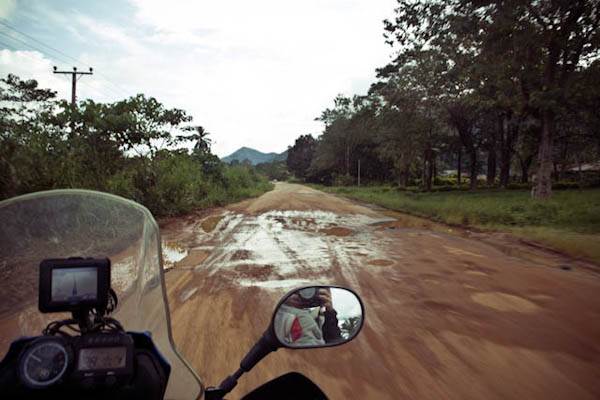

The roads are bad though, so after Obudu we decide to crash overnight at Afi Drill Ranch. Emi and Oli, the Brits overloading in a Landie who we'd met in Lome and who are ahead of us in Gabon, told us to stop in Afi, if we had the time.
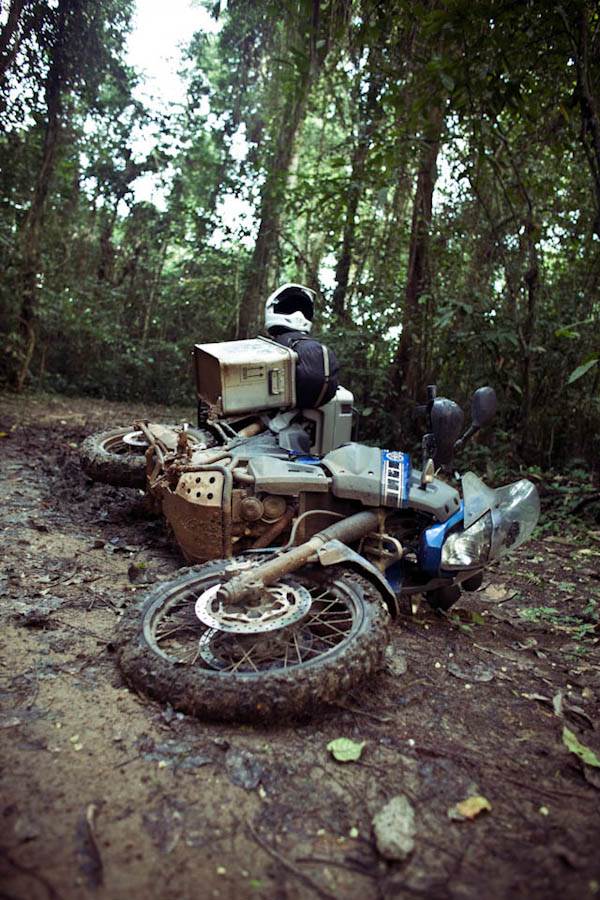
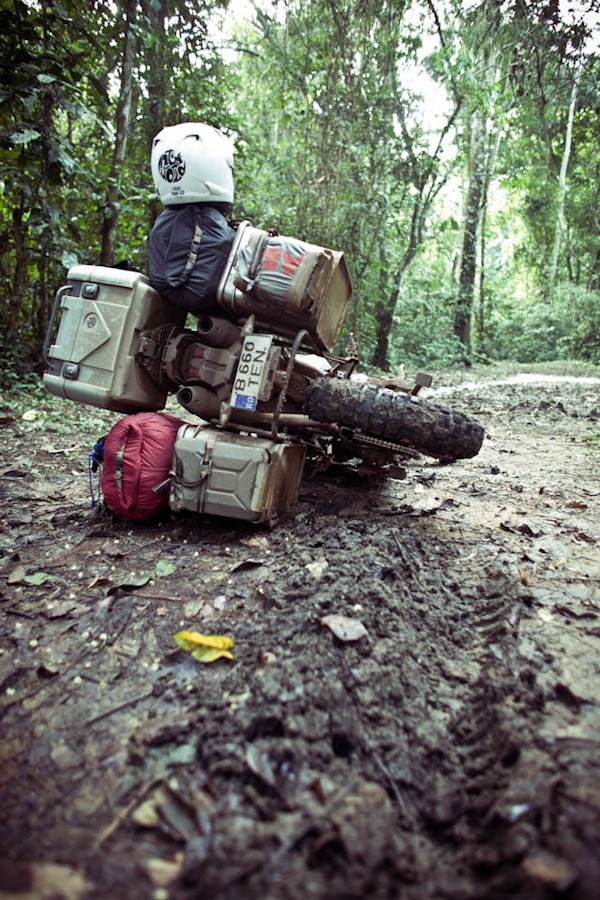
The air is moist, the forrest is soaking and we are rolling through dense high vegetation that hardly allow any sunlight in the undergrowth. The track is narrow and goes up and down for 15 km into the dark heart of the rainy forest. It rains every day, sometimes even more times a day. The tires slide easily or the sticky mushy clay, so a fall is imminent. We bite the mud two times, but we arrive in one piece, yet covered in dirt and with rivers of sweat flowing from the forehead to the boots.

We're in the deep bush. There is no GSM network, no electricity and no running water. Afi Drill Ranch is the research camp of Pandrillus, a conservation project dedicated to saving the primates and the forest of Cross River state from extinction. The camp is bordering the wildlife sanctuary established together with the state government. The project receives short teem visitors who can witness the daily work and learn about primates conservation. We are welcomed by 2 American long term volunteers, Amanda and Jens, who show us around.

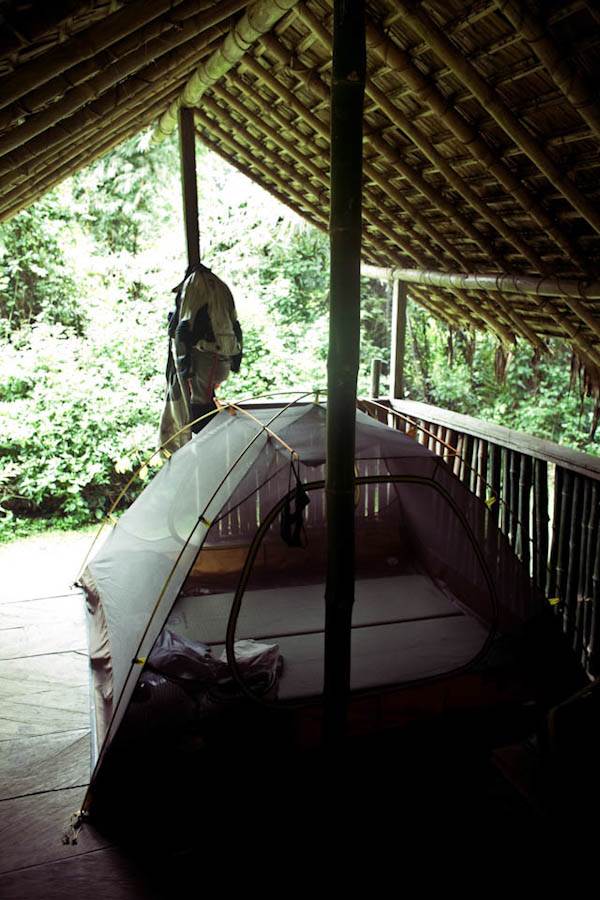
We are completely exhausted. Soon we lay down in our tent, pitched in the bamboo shed.
The night is magical. The darkness burns the eyes and is hardly interrupted by myriad stars and immense fireflies. A choir of forrest sounds - amphibians, insects and nocturnal mammals - completely new to our ears. We let this new energy burn its imprint into our DNA.

We're having a scottish breakfast in the middle of the rainforrest
The route to Calabar is long and hard: area boys, potholes and traffic jams all over. But the city of Calabar is pleasant and clean. A very un-Nigerian place, where people walk the streets, where there are no okadas, with good fresh produce markets and a suya arcade.

We are camping right by the main drill enclosure, next to the crocodiles and the duika, in the yard of Pandrillus HQ, which is also the home of Peter Jenkins, the founder of the project. Him and Lisa Gadsby arrive in Nigeria while overloading in Africa. They had a 10 days transit visa and a meeting with destiny. They discovered that the Cross River subspecies of drill monkey, assumed to be extinct, was still roaming the forests, and they embarked on a race to save them. More than 20 years later, Pandrillus has become one of the world's most successful conservation & captivity breeding of an endangered species projects. It is amazing that such a project exists in the impoverished West Africa and in Nigeria, of all the places. To us it was logical to volunteer our time and effort, and a privilege to be accepted. We sorted out our papers (visa and laissez passer extension) and went shopping for working gear (trousers, long sleeve shirt, shoes) from the second hand shacks in the market. By the end of the week we were already back in the midst of primary rain forest. We were not to exit this unique but dwindling wildlife sanctuary for the next four weeks.
|

4 Dec 2011
|
|
Registered Users
Veteran HUBBer
|
|
Join Date: Mar 2010
Location: Bucharest, Romania
Posts: 117
|
|
|
What are Afi Mountain Wildlife Sanctuary, Afri Drill Ranch and Pandrillus?
Information provided by Pandrillus. Photos by us.
www.pandrillus.org
Pandrillus is a Nigerian NGO that promotes survival of one of Africa's most endangered primates, the drill monkey. The main activity is the Drill Rehabilitation & Breeding Center project (nicknamed "Drill Ranch"), conducting conservation research and survey work in Nigeria and Cameroon, where it also co-manages the Limbe Wildlife Center. The project also provides sanctuary to 28 rescued orphan chimpanzees, the older ones living in their own natural forest enclosure at Afi Drill Ranch, while the youngest live together in a chimp nursery in Calabar.
What is a Drill?
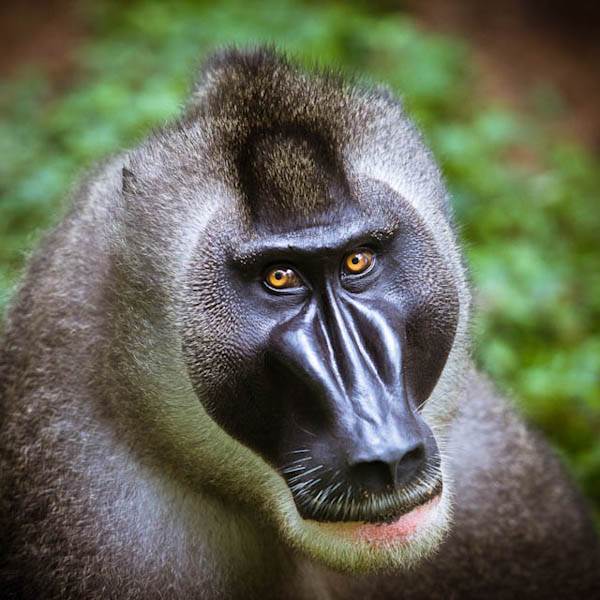
Bulli, the challenging male to the alpha in Group 6, Ochu
Drills (Mandrillus leucophaeus) are large, short-tailed rain forest monkeys, endemic to Cross River Sate, Nigeria, south-west Cameroon and Bioko Island, Equatorial Guinea. Drills have a smooth black face, males have wider faces with intense magenta and purple coloration in genital area and around the cheeks, and they can surpass 45 kg. They have a particularly well-formed thumb, they communicate with facial expressions, vocalizations and specialized behaviors. Unlike most monkeys, drills are semi-terrestrial, searching the ground for food (fallen fruit, roots, leaves, insects, invertebrates), climbing the trees to forage and to sleep at night. They are also semi-nomadic, traveling long distances in the forest, perhaps following fruiting seasons of different trees. Like most primates, they are highly social and live in groups of 15-30. At certain times of the year super-groups of up to 200 animals can occur in the wild, allowing individuals to leave the group they were born in and join another, thus preventing in-breeding. Unfortunately these extraordinary animals are in danger of extinction. Hunted illegally for bushmeat, with only 40,000 sq km of natural range impoverished by logging, farming and human developments, drills are a top conservation priority among the 60+ African primate species. Little is known of drill ecology, as they are elusive and not well studied in the wild. The world population if wild drills is less than 10,000 and could be as low as 3,000.
Drill Conservation

The first step is to learn exactly where drills still live and which populations have the best chance of survival. Liza and Peter completed in 1989 a survey of Nigeria and covered most of Cameroon (which has over 60% of world's drill habitat). Drills are protected from hunting in Cross River National Park in Nigeria and the Korup National Park in Cameroon. In May 2000 the Cross River State Government created the Afi Mountain Wildlife Sanctuary, where wild drills, gorillas, chimps and other endangered species survive. Still, forests are difficult to secure against poachers. Former hunters are being employed as wildlife rangers, to patrol the sanctuary, in an award-winning community-based protection scheme. Recently Peter has created the first ever Task Force that is fighting illegal logging in an attempt to protect the wildlife habitat of these endangered species.
Drills are rare in captivity and they reproduce poorly in zoos, where they lose some of their native instinct and are not likely to successfully return to the wild. While conducting survey work in 1988, Peter and Liza discovered infant drill in villages, by-products of hunting of nursing mothers shot for bushmeat. They decided to salvage this potentially valuable conservation and genetic resource and to raise the primates in natural-sized social groups in their own habitat. The Pandrillus project promotes habitat protection education and awareness about the importance of endangered wildlife conservation.
What is "Drill Ranch"?
The Ranch started in 1991 with 5 drills, and by January 2009 298 drills - over 75% of captive drills in the world - were living in Afi. Most drills were donated by citizens of Cross River; some were recovered by wildlife or park officers, or police. Two monkeys were recovered from Asia, from the hands of international smugglers. The project never buys animals, because it's illegal and we must not encourage wildlife trade. Drills usually arrive as infants and, after quarantined, grow and live together in 1 of the 6 groups, in solar-powered electric enclosure of naturally forested drill habitat in the Afi River Forest Reserve, Boki LGA, Cross River State, Nigeria. The first group of drills was flown by helicopter to Afi in 1996.
The project is home to Africa's first captive drill birth and world's first ever twin birth in captivity, and has witnessed more than 200 births since its start. The nearest villages (Buanchor and Kataba) benefit greatly from the project: permanent staff is employed from there and most animal food is purchased from local farmers.
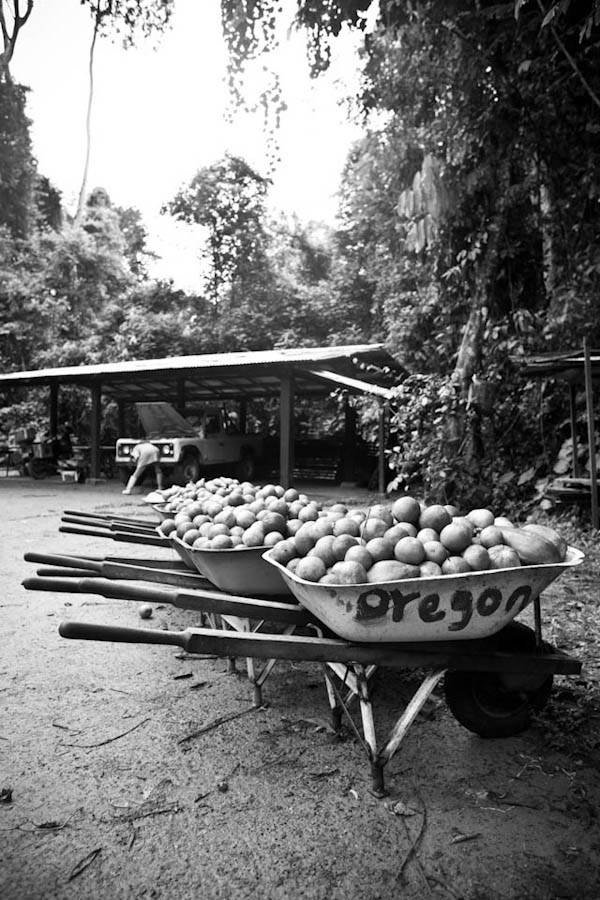
The wheelbarrows with fruits for one of the 3 daily feedings. Each will feed a group of drills, the scarcity of the food encourages the drills to continue foraging and prevents them from becoming dependent.
The Graduation
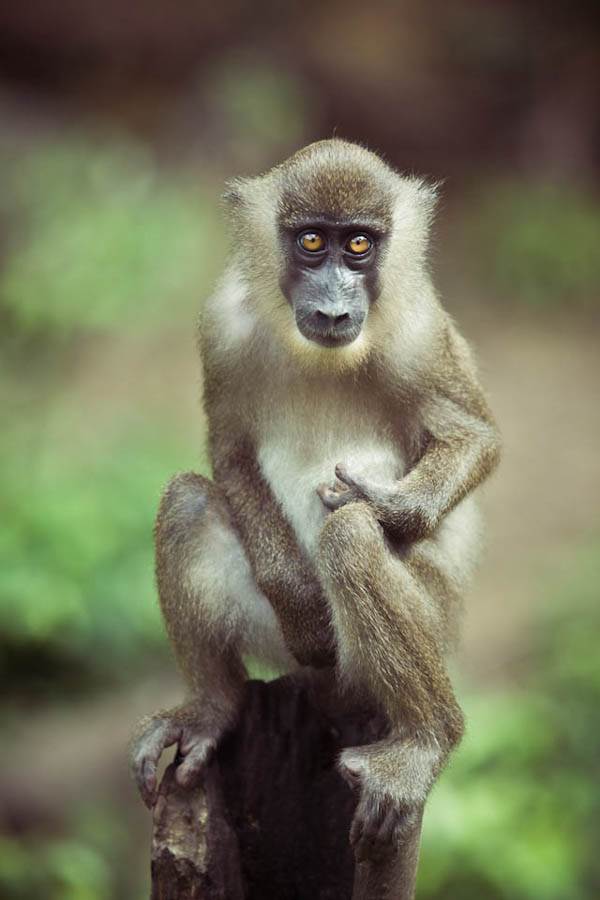
The project has been working for this pioneering event for over 5 years. If the project will be able to maintain sustainable protection of the Afi Mountain Wildlife Sanctuary, the super-group of over 130 drills will be released from Enclosure 1 on Afi Mountain, in a carefully monitored program. The Graduation will be a worldwide premiere and is scheduled for 2012, during fruiting season, with various scenarios planned. The super-group is expected to split into 3 to 5 groups, and the larger males - who will potentially assume dominance within the new groups - will carry collars.
Chimpanzees in Drill Ranch

Maya
Another world record is about to be completed in Afi Ranch. The staff is working on the largest ever naturally forested enclosure for chimps, a beautiful 12 ha of primary rain forest, where the rescued chimps will be living a decent life, along members of their own species. Chimpanzees are 99% genetically identical to humans and after living in miserable captivity for years - in poorly managed zoos or as pets - they cannot re-adapt to life in the wild. The project offers home to rescued chimps, but does not encourage captive breeding. The chimps in Drill Ranch are divided in 2 heterogeneous groups, dominated by 2 alpha males: Willy and Jacob. The oldest chimpanzee is 42 years old and there is also one lowland chimp, rescued from Guinea, named Pablo.
How is Drill Ranch funded?
The project is funded by direct donation in Nigeria, the fund-raising efforts of Pandrillus Foundation in the USA and Rettet den Drill in Germany. The Cross River State Government provides monthly contribution for staff salaries and animal feeding and has donated a vehicle and funded eco-tourism infrastructure that brings in revenue. Non-national staff, including Liza and Peter, work for free, with about 40 Nigerian staff on salary. The project has a tree nursery where native species are being grown from seedlings, then sold for a modest fee to the forest department for re-planting. Pandrillus works in cooperation with the Cross River State Forestry Commission, Ministry of Environment and Tourism Bureau. Pandrillus offers a yearly grant for a green project developed by a Boki villager.
|

4 Dec 2011
|
|
Registered Users
Veteran HUBBer
|
|
Join Date: Mar 2010
Location: Bucharest, Romania
Posts: 117
|
|
|
Our Stint with Pandrillus - Part I
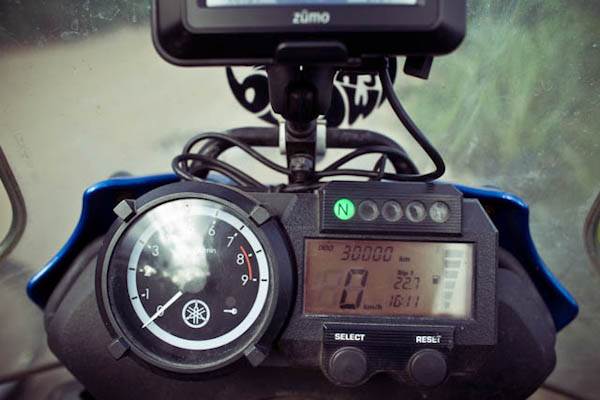
Day 118. We reached the 30,000 km on the clock, and the next km will be only logged while moving to our working sites or going to the next village, Buanchor, where sometimes there is GSM signal.
Working day starts at 8 a.m. with a staff briefing, there is also a 12 am - 1 pm lunch break. Crew boys - supporting personnel who perform most endurance tasks - finish work at 4 pm, the rest of us at 5 pm. We cook our own fod, dinner being sometimes served in the secondary staff shed, where we cooked and socialized, learning words in local dialects, how to use wild vines for the traditional Nigerian food (like egusi) and abusing the local staple, garri - a casava flour that we used for pancakes, tortillas and deserts.
We are deeply grateful to our colleagues, the management and in particular to Peter Jenkins, for the opportunity to work together in one of the most successful and important conservation projects in the world.
Satellite 6 & 1 works

Cutting and pre-drilling the frame pieces
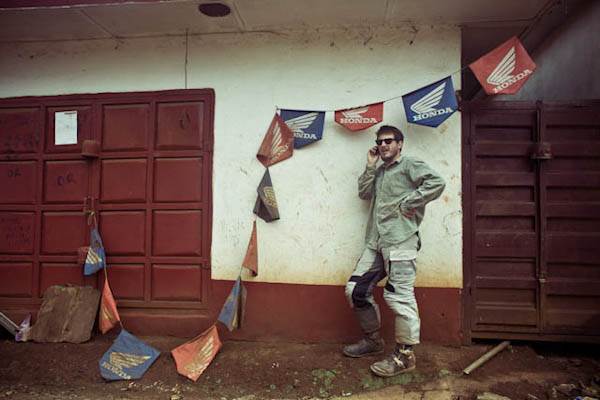
A quick run to Ikom, to sort out our Laissez-Passer extension
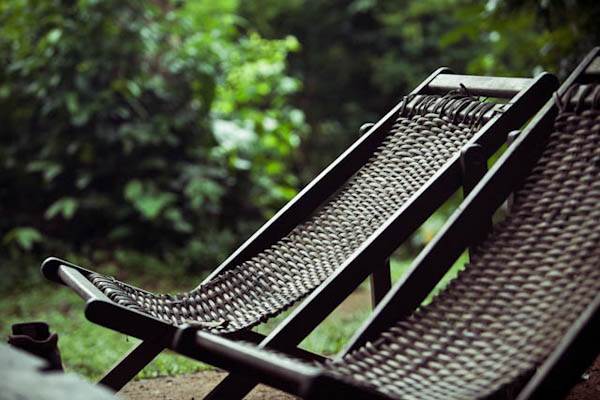
After work we would relax in the communal area, the main shed

The view from the main shed towards the Afi Mountain it's never the same.
Satellite 6 - 2 days, individual work

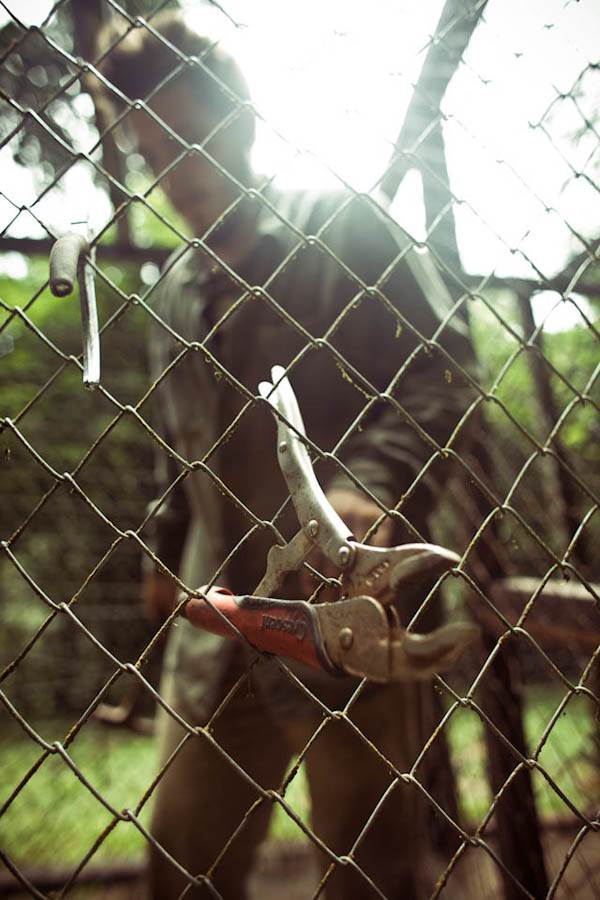
We replaced rotten wood, fitted the panels with mesh, repaired broken frames, built new platforms for the quarantined drills and designed, built and fitted door stoppers for the sliding doors that connect the satellite to the enclosure and that separate the 2 compartments inside the satellite. After work we cleaned the site from debris and transported all scraps to the garbage pit and to the storage from where wood can be recovered for making fire.

On the Canopy Walkway, the second largest in Africa, suspended at over 30 meters in the trees.
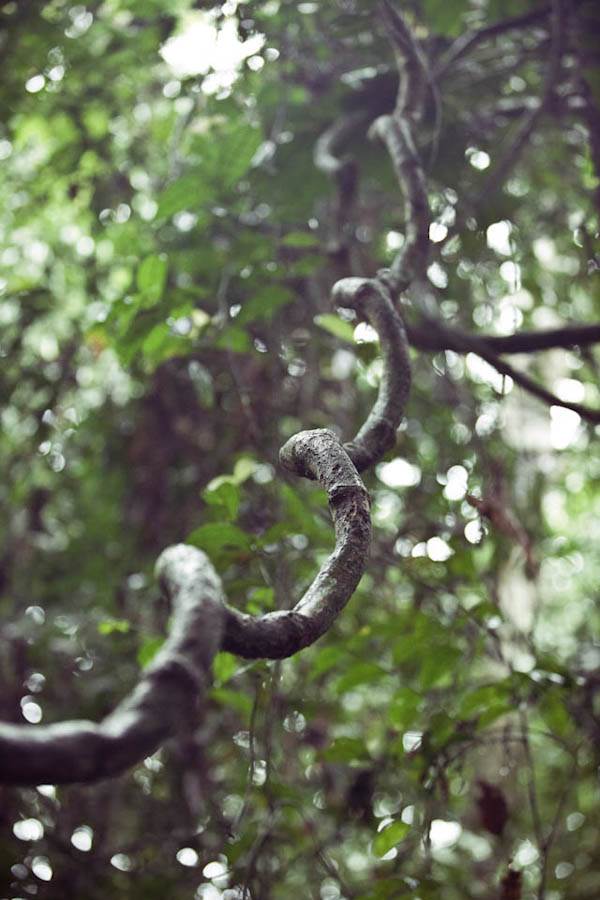
Lianes are parasite plants typically found in the tropical forests
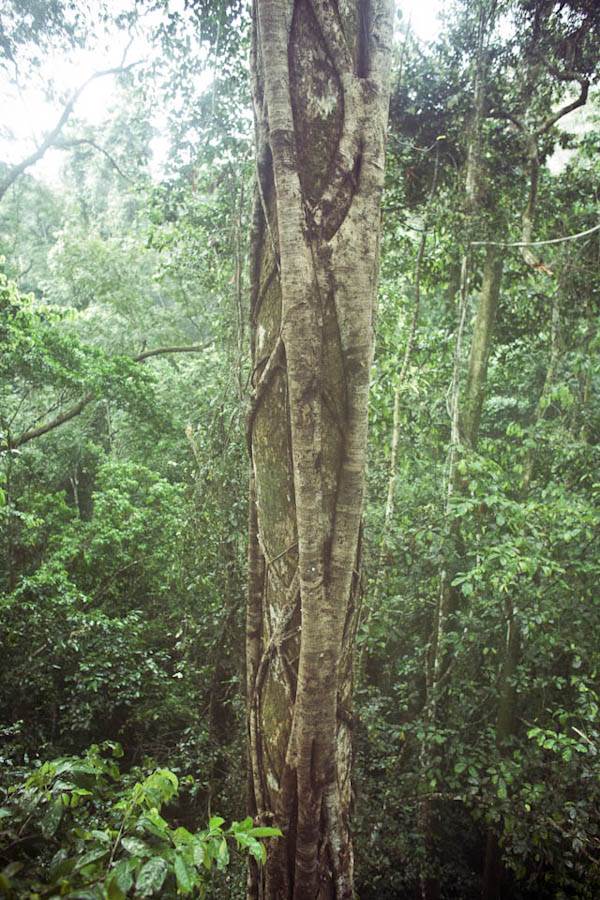
A parasite tree is slowly murdering its host
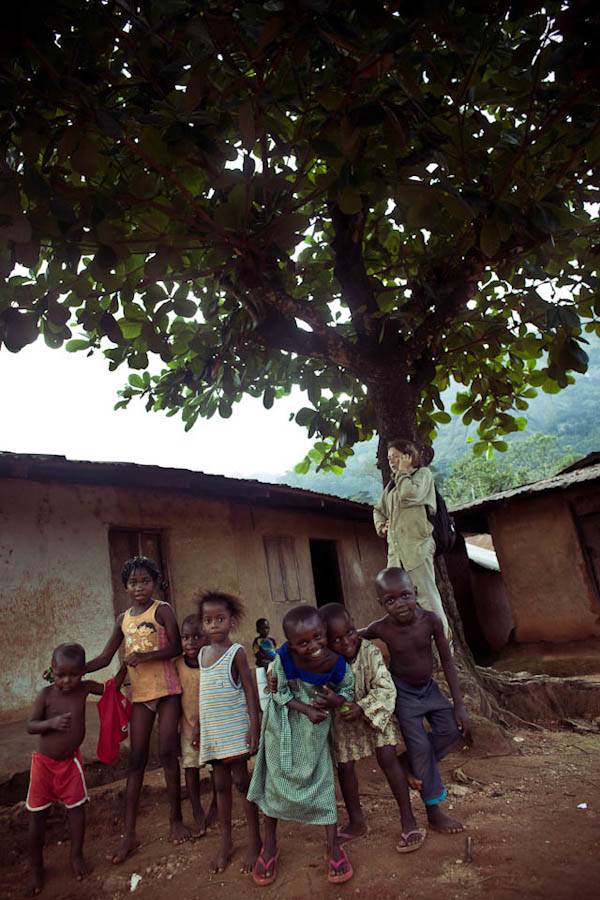
At the magic tree in Buanchor: the village GSM antena.
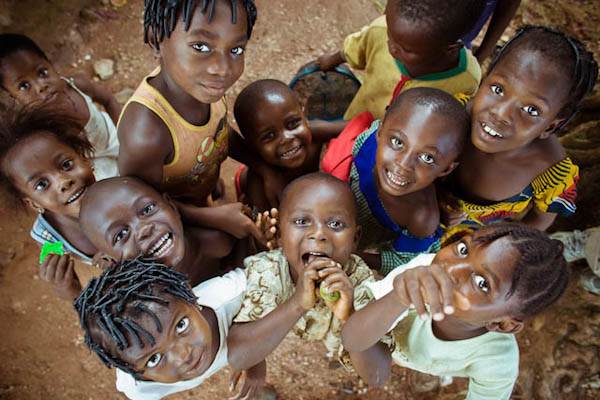
Kids in Buanchor
Survey Work

We completed and assessment of the entire built base, highlighting: what needs to be fixed, replaced or improved in visitor and staff cabins, sheds and animal enclosures, we tagged with red tape the fence poles that are must be changed, suggestions for an improved layout of the vet shed, tool shed and fuel shed in relation to the main staff shed and the working area. We proposed 2 washing points (water birds) with easy access from the toilets and water source (stream). One important aspect is using as many materials from site as possible and keeping the budget to a minimum.
Our second survey work was assessing the new chimp extension which is a big operation: we proposed an improved working flow taking into account manpower and materials availability and sources (gravel and sand are difficult to bring to the site because the terrain is quite irregular and even marshy). We proposed a prototype for the 7 bridges that would ensure easy access around the enclosure for maintenance staff and an ATV. We proposed solutions for terrain works in particularly delicate areas (2 marshes and one area very difficult to cross). Bridge proposal follow a few main ideas: using materials already on site, using as little concrete as possible to keep pollution to a minimum, keeping the site clean for debris, building a cheap wood strecher-like container for concrete mixing (to avoid several pits difficult to clean afterwards) and following a simple but strict work flow.

Riding the truck to Buanchor

American pancakes with garri and bananas by Jens

Shaua-Shaua, the wild pineapple. In the background is CJ.
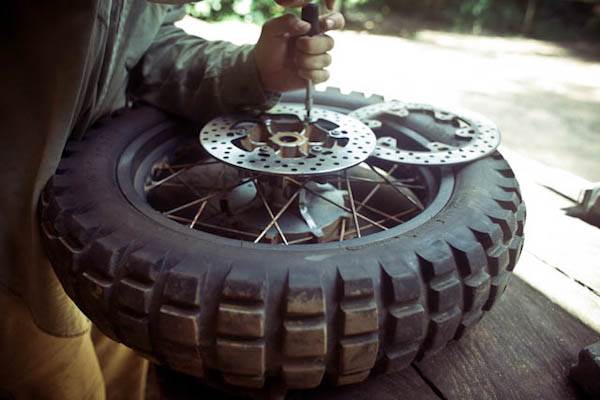
Changing the brake disc, thanks to our invaluable friend, Harry.
|

4 Dec 2011
|
|
Registered Users
Veteran HUBBer
|
|
Join Date: Mar 2010
Location: Bucharest, Romania
Posts: 117
|
|
|
Our Stint with Pandrillus - Part II
President Obasanjo
Former star president of Nigeria, Olusegun Obasanjo arrived at the ranch 10 years after his first visit. It was an intense team effort to prepare the camp for his visit and it was great fun to have him over and to get to know him. Years back in Galati or Bucharest we would have never thought that us, two ordinary Romanians, would get to know the president of Nigeria, and the most famous and powerful nevertheless.
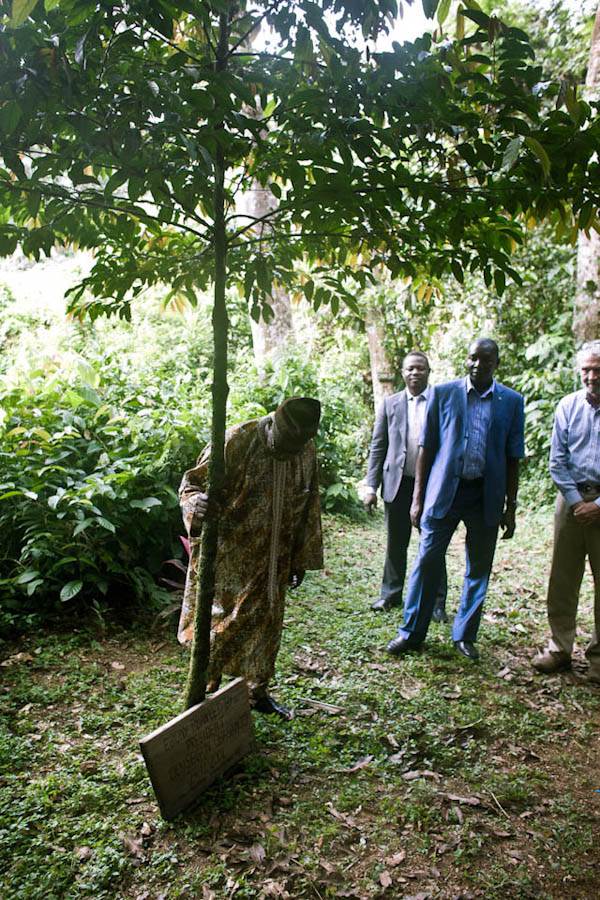
President Olusegun Obasanjo posing with the ebony that he planted here 10 years ago. Ebony is one of the most precious essences in Africa, it's very resistant to humidity and was traditionally used for bridges in Boki region, but is now under threat of being forested into extinction.

At the chimp platform where I had build 2 new visitor benches. CJ is the star of the day, making a brilliant presentation for Obasanjo and the entourage
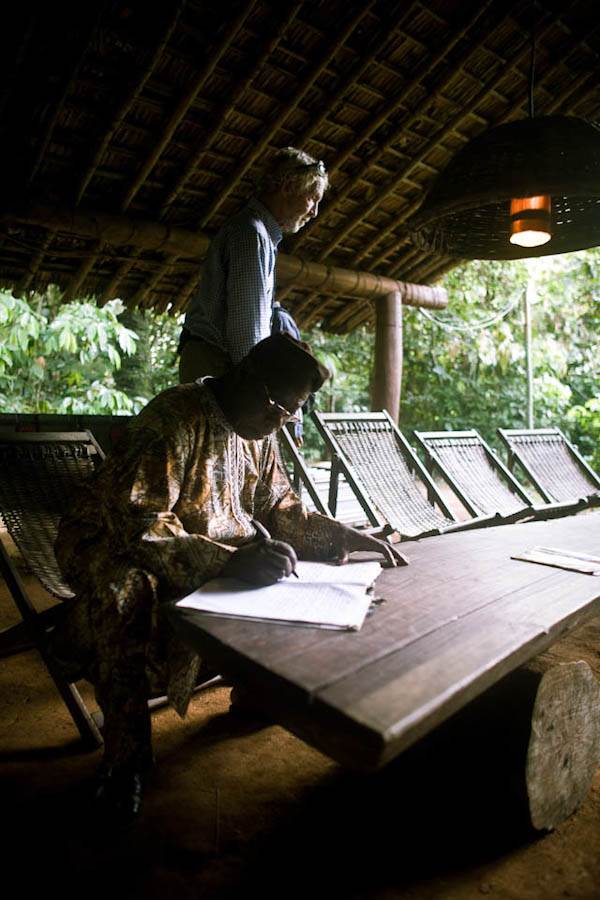
Obasanjo signs the guest book, while Peter Jenkis acts as the man in the shadow.

Asuko (senior drill keeper in group 1 & 6) shows Poto, who is rather unhappy to be disturbed from his usual daytime sleep

President asked us to take a photo with him, and we happily obliged. Now we are waiting for Jonathan.
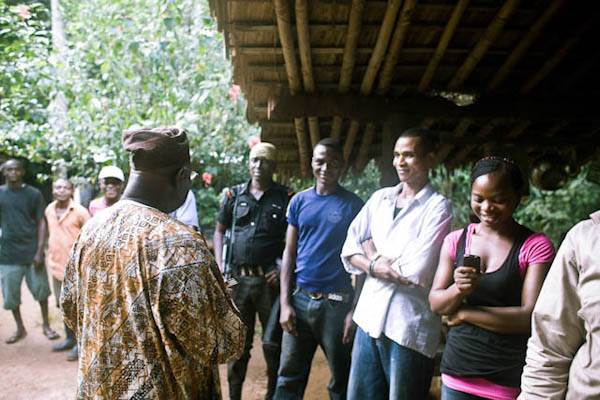
The president meets permeant staff: Takam (crew boy), David (group 6 & 4) and Franca (animal food); the armed dude is from the escort

The strong jaw of the president next to more ranch staff: Tony (group 1 & 6), Gabriel (group 2, 3, 4), James (group 2 & 5), Rose (housekeeping), Thomas (group 5, fence maintenance)
Chimp Septic - 5 days, 4 crew boys (1 for digging, 2 for mixing and pouring concrete, 1 to wheelbarrow materials)
Cleaning and maintenance of the two big and crowded chimp satellites was top priority. The faces, solids and liquids are difficult to collect and remove from site. Problems are: staff medical issues like frequent eye and skin infections, pools of dirty matter where mosquitoes quickly reproduce generating an unmanageable infested area and most of all, pollution of the nearby stream via a channel that carries all dirty waters. We proposed a septic pit: 95x155 cm, 1.60m deep, concrete walls, no bottom. We would lay gravel and then sand on the bottom of the septic, allowing the dirty matters to slowly be filtrated. The solids would by then be partially be consumed by insects and the surplus can be shoveled to the main garbage pit. The septic would be connected with a concrete gutter to the satellite, and would have a wooded pedestrian cover, making it easy to maintain and service. We would fit the septic wit an overflow: PVC slotted pipes that would direct only filtered liquids and meteoric water to the stream.

We eliminated the polluting drain system towards the stream, we closed the gutter in the satellite, we marked and dug the pit

We sent crew boys for sand and stones, which we then pounded to the desired granulation. We designed the concrete recipe.
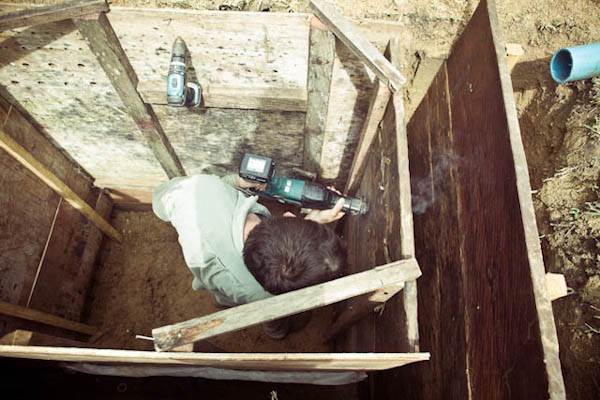
We built and placed the forms. As we were using scraps, we struggled to level the faces.

Forms, reinforcing wire and overflow drain fitted

With my crew boys for the day: Mathew and Godwin. We prepared a semi-wet premix on the floor, then correct the consistency in the wheelbarrow, and poured with a metal basinet. We vibrated with an old iron.

Walls and washing platform done.
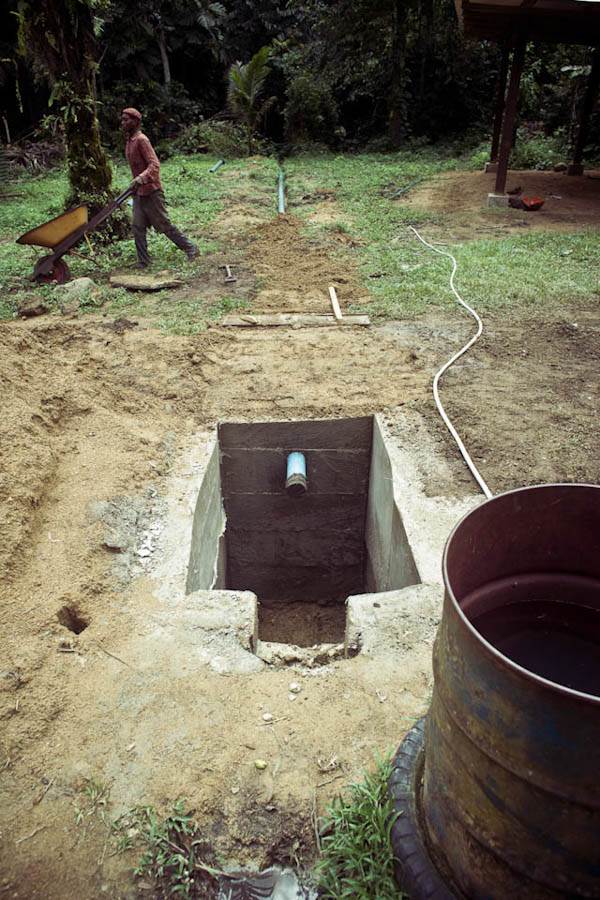
We dismantle the forms. The walls are not perfectly plane, but the concrete is impeccable
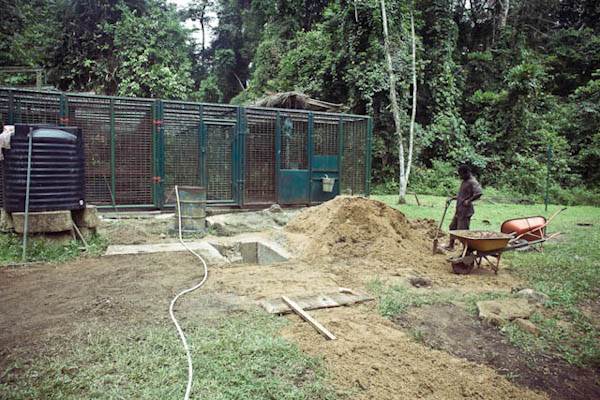
Godwin covers the drain with soil

We poured the connection gutter to the satellite.
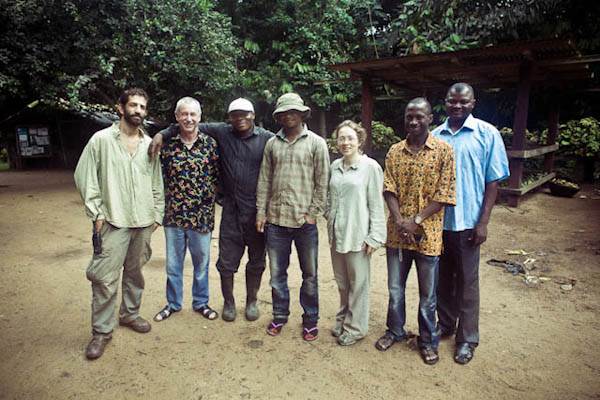
Typical staff & visitors photo. From felt to right: Jens (from Oregon, volunteers for 1 year), a German visitor, Asuko (Senior drill keeper, from Calabar), Mageed (vet and manager), Ana, visitor & driver
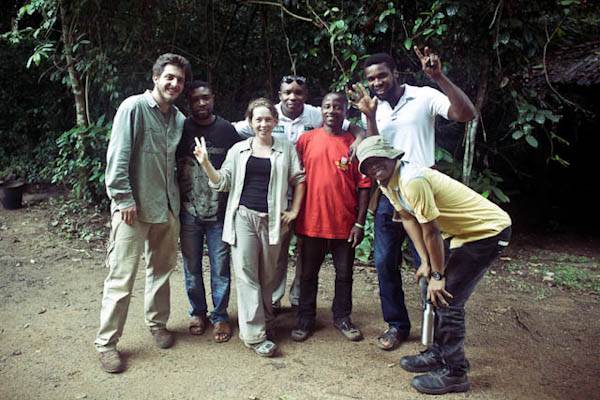
From left to right: me, Nasseru (welder), Ana, Asuko, Celestine (driver), CJ, Mageed
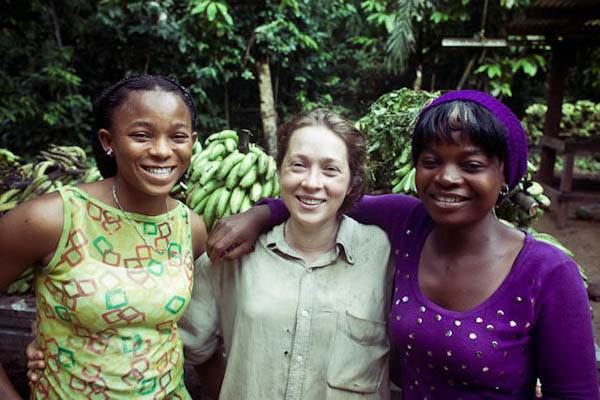
Rose, Ana, Franca

Takam

Me, Peter, Ana, Godwin, Emmanuel 1, Amanda, Mathew, takam, Tony, Thomas, James, Gabriel, Robert, Emma 2
Final group photo, the departure morning.
|

4 Dec 2011
|
|
Registered Users
Veteran HUBBer
|
|
Join Date: Mar 2010
Location: Bucharest, Romania
Posts: 117
|
|
|
Wildlife and Nursing Animals

Harry Poto - a 1 year poto adult, rescued after suffering a life threatening injury to the head. Its a nocturnal low rank primate, it feeds on fruit and insects and has chosen to stay in Afi, nobody knows why.

Green Tree Viper - the adult measures about 40-45 cm, it's poisonous but not dangerous. We saw it sleeping one cold wet morning by our water tank. The next morning, it was gone.


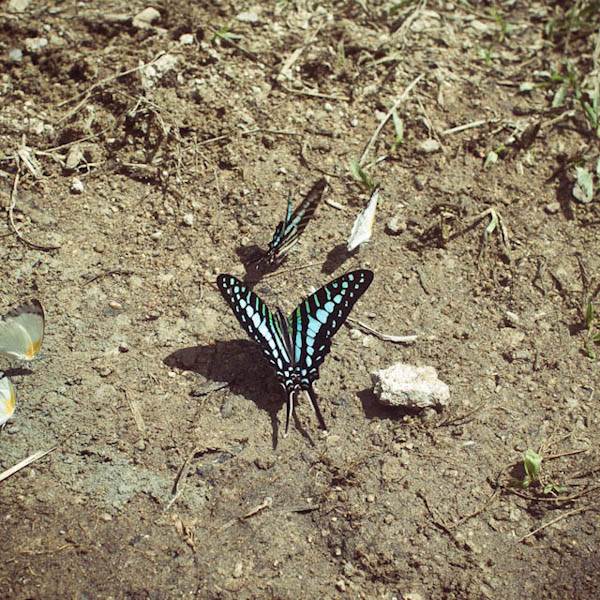
The many amazing butterflies that lives in Afi, some as big as a palm are still little known. Their food of choice are rotten bananas.

Lala, the wild civet baby who arrive in the cam soon after us. She is barely 1 month old and her mother and sister were killed by some farmers. While we were in camp, I was her daddy, nursing her with milk and taking her to matinal and evening outing in the undergrowth. Civets grow to the size of a Labrador, are nocturnal and carnivores, but unfortunately orphan babies have a less than 40% chance of survival.
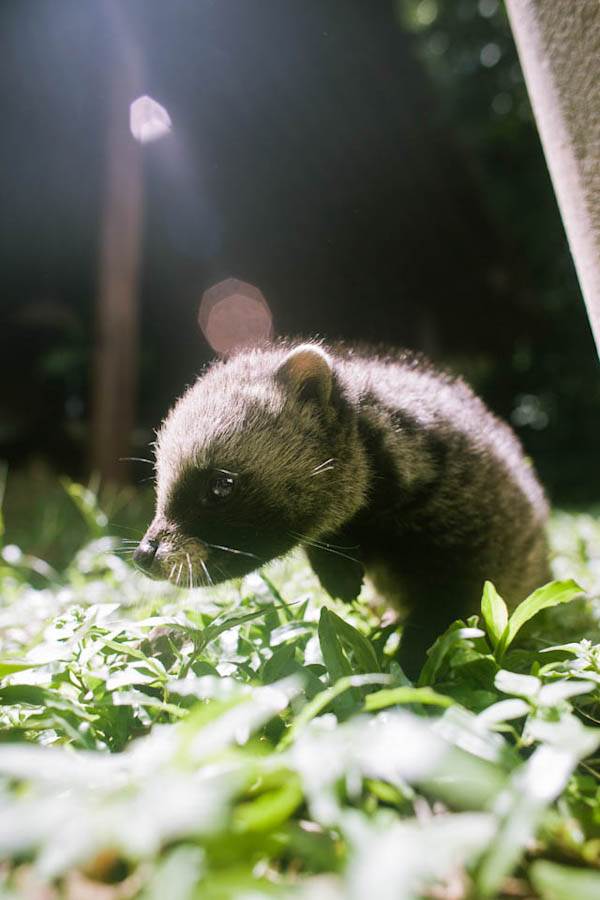
Lala

Rhinoceros beetle. It lives in the palm stem and its larvae are edible. This one is a male.

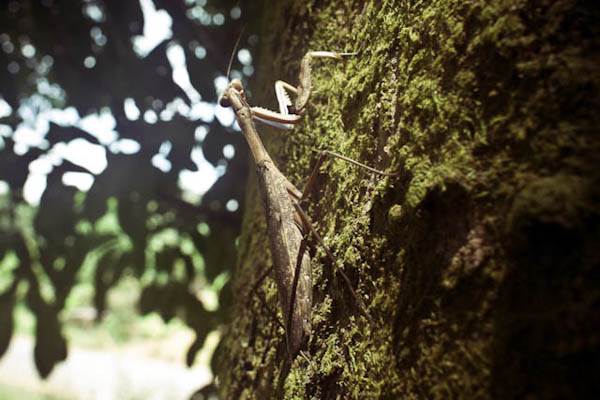
Praying Mantises

Pius, the 4 months old porcupine who is recovering well after severe injuries from a drill attack. He will return to the wild within a couple of months.
Chimpanzees In Afi
There are two main groups: the chimps in the natural enclosures and the ones in the satellites, who will be release in their new world record home next year. Chimps in the satellite have been rescued from miserable captive conditions. They have never experienced freedom and the chimp extension is destined to provide them with that for the first time in their life. After spending all their life close to humans, these chimps can never successfully return to the wild.

Waiting for their new primary forest enclosure to be finished



Lucy

Murphy, the former alpha male in the enclosure

Pablo, a lowland chimp with a slight paresis
|
|
Currently Active Users Viewing This Thread: 1 (0 Registered Users and/or Members and 1 guests)
|
|
|
 Posting Rules
Posting Rules
|
You may not post new threads
You may not post replies
You may not post attachments
You may not edit your posts
HTML code is Off
|
|
|
|

Check the RAW segments; Grant, your HU host is on every month!
Episodes below to listen to while you, err, pretend to do something or other...

2020 Edition of Chris Scott's Adventure Motorcycling Handbook.
"Ultimate global guide for red-blooded bikers planning overseas exploration. Covers choice & preparation of best bike, shipping overseas, baggage design, riding techniques, travel health, visas, documentation, safety and useful addresses." Recommended. (Grant)

Led by special operations veterans, Stanford Medicine affiliated physicians, paramedics and other travel experts, Ripcord is perfect for adventure seekers, climbers, skiers, sports enthusiasts, hunters, international travelers, humanitarian efforts, expeditions and more.
Ripcord Rescue Travel Insurance™ combines into a single integrated program the best evacuation and rescue with the premier travel insurance coverages designed for adventurers and travel is covered on motorcycles of all sizes.
(ONLY US RESIDENTS and currently has a limit of 60 days.)
Ripcord Evacuation Insurance is available for ALL nationalities.
What others say about HU...
"This site is the BIBLE for international bike travelers." Greg, Australia
"Thank you! The web site, The travels, The insight, The inspiration, Everything, just thanks." Colin, UK
"My friend and I are planning a trip from Singapore to England... We found (the HU) site invaluable as an aid to planning and have based a lot of our purchases (bikes, riding gear, etc.) on what we have learned from this site." Phil, Australia
"I for one always had an adventurous spirit, but you and Susan lit the fire for my trip and I'll be forever grateful for what you two do to inspire others to just do it." Brent, USA
"Your website is a mecca of valuable information and the (video) series is informative, entertaining, and inspiring!" Jennifer, Canada
"Your worldwide organisation and events are the Go To places to for all serious touring and aspiring touring bikers." Trevor, South Africa
"This is the answer to all my questions." Haydn, Australia
"Keep going the excellent work you are doing for Horizons Unlimited - I love it!" Thomas, Germany
Lots more comments here!

Every book a diary
Every chapter a day
Every day a journey
Refreshingly honest and compelling tales: the hights and lows of a life on the road. Solo, unsupported, budget journeys of discovery.
Authentic, engaging and evocative travel memoirs, overland, around the world and through life.
All 8 books available from the author or as eBooks and audio books
Back Road Map Books and Backroad GPS Maps for all of Canada - a must have!
New to Horizons Unlimited?
New to motorcycle travelling? New to the HU site? Confused? Too many options? It's really very simple - just 4 easy steps!
Horizons Unlimited was founded in 1997 by Grant and Susan Johnson following their journey around the world on a BMW R80G/S.
 Read more about Grant & Susan's story
Read more about Grant & Susan's story
Membership - help keep us going!
Horizons Unlimited is not a big multi-national company, just two people who love motorcycle travel and have grown what started as a hobby in 1997 into a full time job (usually 8-10 hours per day and 7 days a week) and a labour of love. To keep it going and a roof over our heads, we run events all over the world with the help of volunteers; we sell inspirational and informative DVDs; we have a few selected advertisers; and we make a small amount from memberships.
You don't have to be a Member to come to an HU meeting, access the website, or ask questions on the HUBB. What you get for your membership contribution is our sincere gratitude, good karma and knowing that you're helping to keep the motorcycle travel dream alive. Contributing Members and Gold Members do get additional features on the HUBB. Here's a list of all the Member benefits on the HUBB.
|
|
|















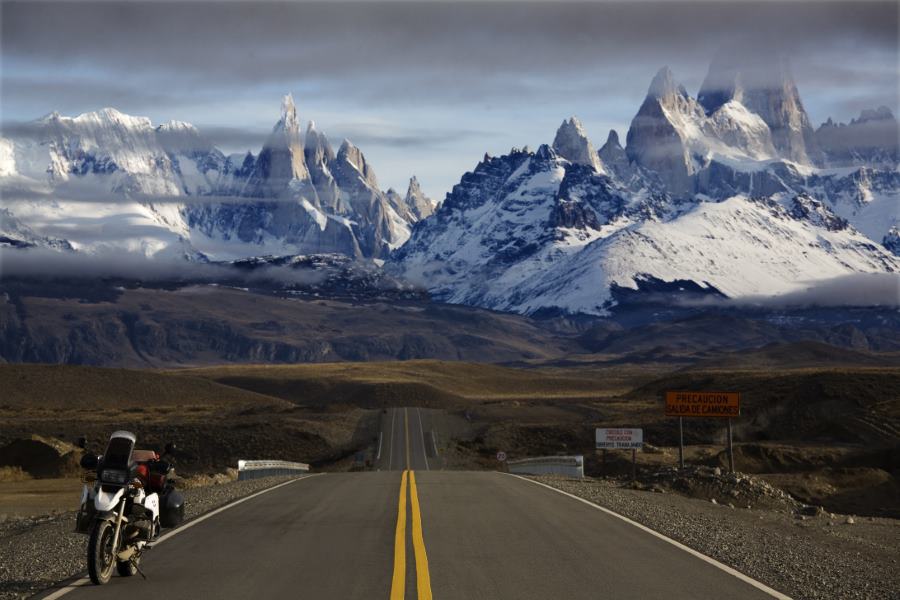

 16Likes
16Likes









































 for the officer… we'll never know). The good news is that gas is cheaper in Togo, at 595 CFA/l.
for the officer… we'll never know). The good news is that gas is cheaper in Togo, at 595 CFA/l.
























































































































































































 Linear Mode
Linear Mode










